How to Go From ‘Just Another Creator’ to Successful Entrepreneur by Writing Online
I first heard the term ‘Creator Economy’ when a friend sent me Naval Ravikant’s podcast How to Get Rich Without Getting Lucky.
As someone who felt trapped in his career, Naval’s ideas shone like a beacon in the fog. “You can go out on the internet,” he explained. “And you can find your audience… build a business… create a product… build wealth, and make people happy just uniquely expressing yourself through the internet.”
But the truth is few people make it as creative entrepreneurs. Most of the results go to the top 1%, whilst the rest are left fighting for the scraps. For example, recently, I surveyed my audience — only 8% had monetized. In 2022, Linktree published a report showing that only 12% of full-time creators make more than $50k.
There's a divide between commodity and authority creators, and it's only stretching wider. The purpose of this essay is to make sure you're on the right side of the equation.

Why listen to me?
I’ll hold my hands up — I’m no expert.
In fact, three years ago, I was just a dentist who thought copywriting was for lawyers, Twitter for sports, and ‘internet money’ code for drug dealing.
Fast forward to today, I’m grateful to say I have an audience of over 200,000 people, a popular newsletter, and a multi-six figure content-driven business (with zero drugs except copious amounts of Yorkshire Tea induced-caffeine).
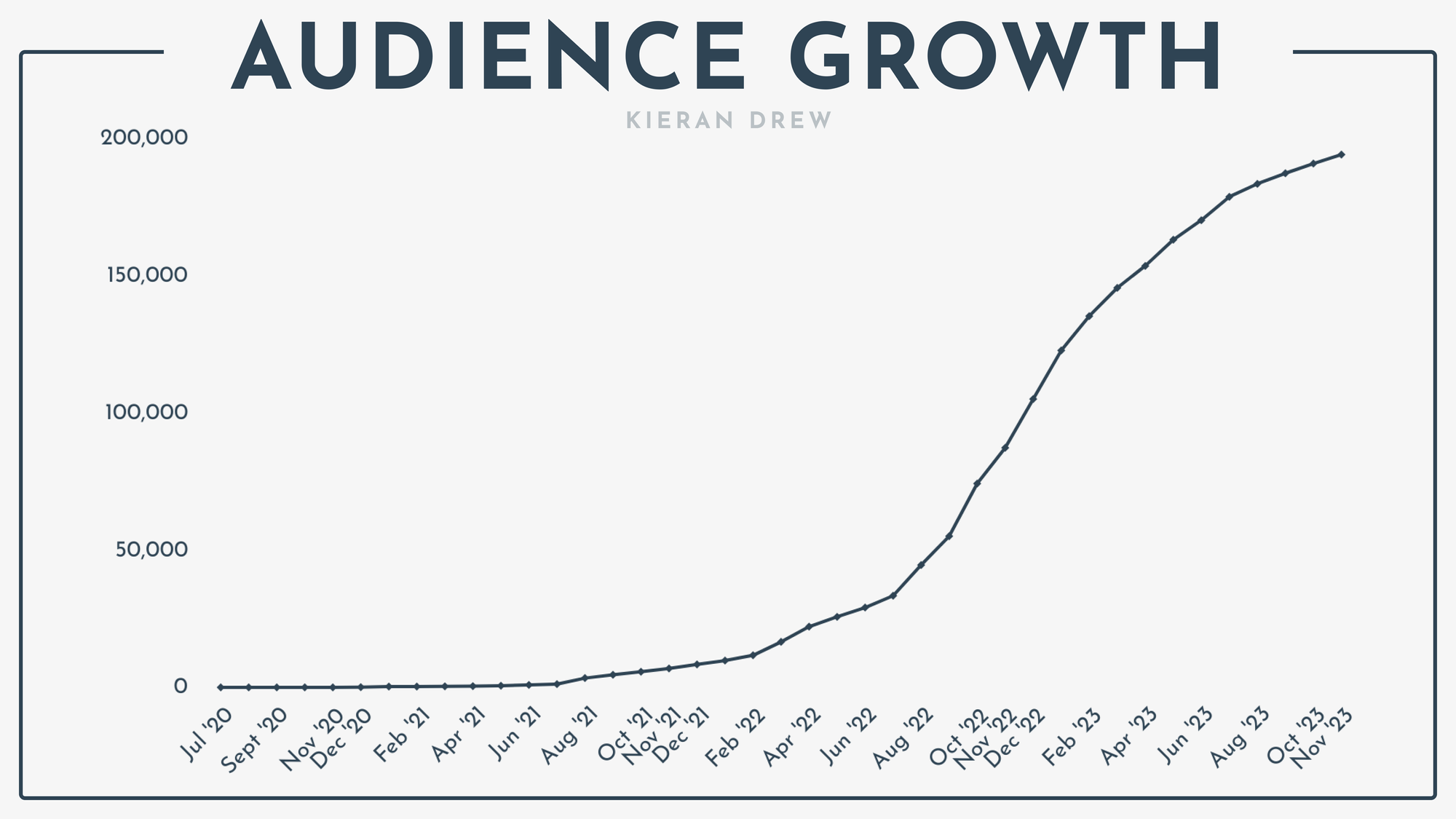
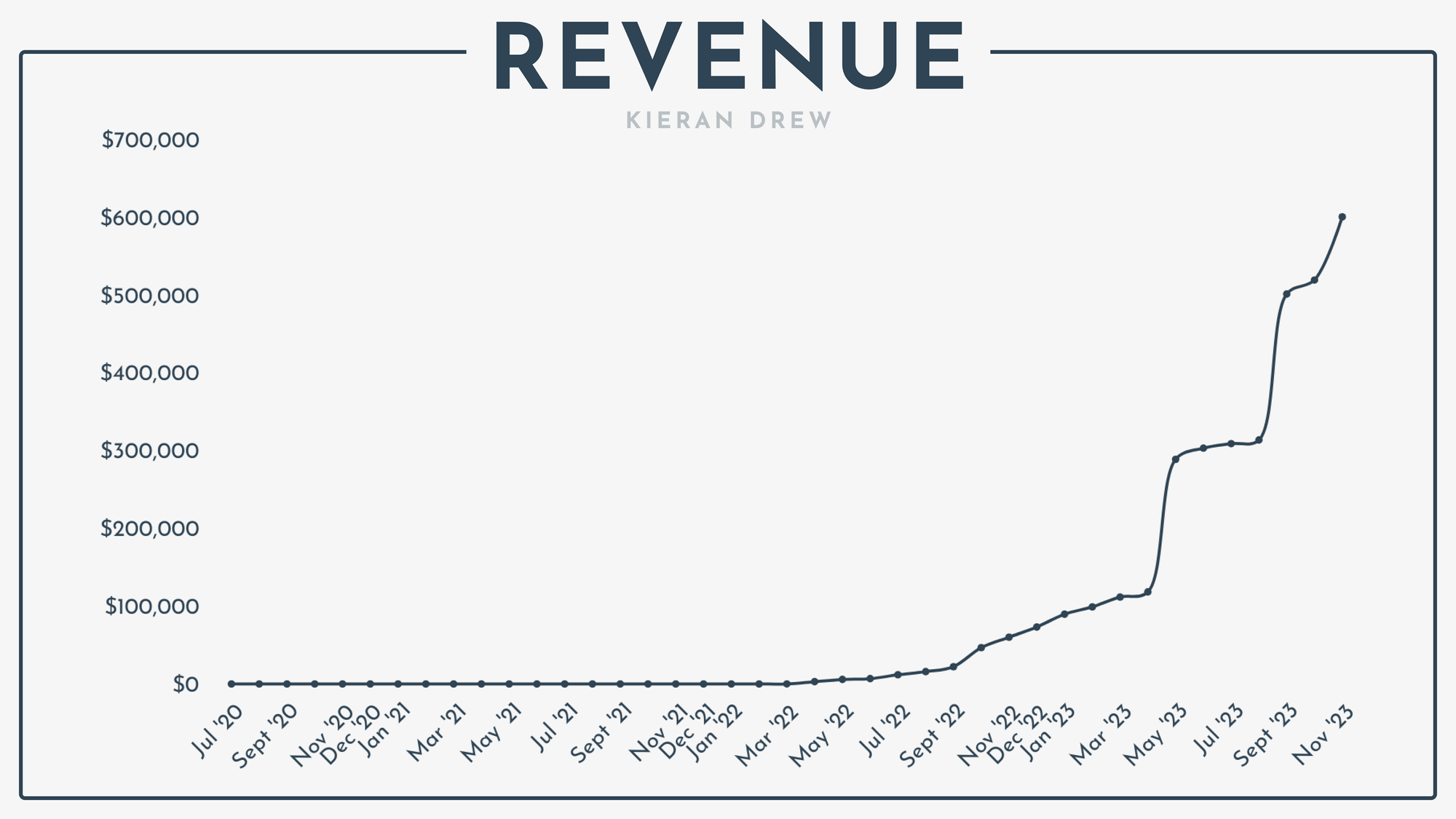
But the start of my journey was awful. I made every mistake under the sun. I still don't have it all figured out — far from it — but the conversation you and I are about to have is the one I wish I'd heard when I started.
We start our journey by deciding how to communicate with your audience.
Out of audio, video, and writing, let me explain why wrestling with words is most worth your time (and why it’s a mistake to focus on more than one medium at the start).
Why writing?
The internet is drowning in commodity content. You might think saturation is an obstacle, but for the writer, it’s an opportunity.
Writing is thinking, and high-quality thinkers are like diamonds in the dirt — hard to find but easy to enjoy.
You might not believe me now, but you have the most fascinating thoughts whirling around in your mind. Writing is the net that catches and pulls them together. The more you explore your thoughts, the more clear and exciting they become.
“Writing about something, even something you know well, usually shows you that you didn't know it as well as you thought. Putting ideas into words is a severe test. The first words you choose are usually wrong; you have to rewrite sentences over and over to get them exactly right. And your ideas won't just be imprecise, but incomplete too. Half the ideas that end up in an essay will be ones you thought of while you were writing it. Indeed, that's why I write them.”
- Paul Graham
Plus, writing is the foundation of the internet.
- Audio
- Video
- Business
- Social media
- Communication with colleagues
No skill will improve every area of your business as effectively.
Let's dive into the first step.
You'll learn about the three phases of the online writer's journey.
1. Exploration
2. Experimentation
3. Entrepreneurship
There'll be useful principles throughout, regardless of your level. I'd recommend reading the essay first and then revisiting what's most useful.
PHASE 1: EXPLORATION
The start of your online journey is like being dropped in a foreign country with no map and no clue. Most people want a big audience and profitable business from day one, when in reality, the first step is finding your feet — walking before you run.
You have three objectives:
- Decide where to write
- Decide what to write
- Decide who to write to
Let’s unpack each.
Where to write
The classic path to a successful writing business is blogging and SEO. This still works, but in a recent podcast, author Mark Manson said blogging is dead.
Obviously you're reading this, so you know it's not, but there’s a faster path:
Social media.
Attention's becoming increasingly valuable. If you want to strike oil, you gotta go where it flows. Picture writing like a magnet. You create content on social media to attract an audience, and then, once you've built a bond, you bring them to platforms you own — like your newsletter or blog.
You have a few platforms to pick from:
- Quora
- TikTok
- Medium
- Twitter (𝕏)
- Instagram/Threads
The best is the one you will enjoy most. All results from social media come from compounding, and compounding requires persistence. The aim is to become an authority in one space and then use that reputation to grow elsewhere.
But I will say this.
The best place to learn how to write is a low-friction, fast-feedback environment. The easier it is to publish, the more energy you have to give. The faster the audience response, the quicker you can improve.
This makes 𝕏 king and LinkedIn a close second. Visuals and video are much less important, and character limits will teach you more about copywriting than any course can.
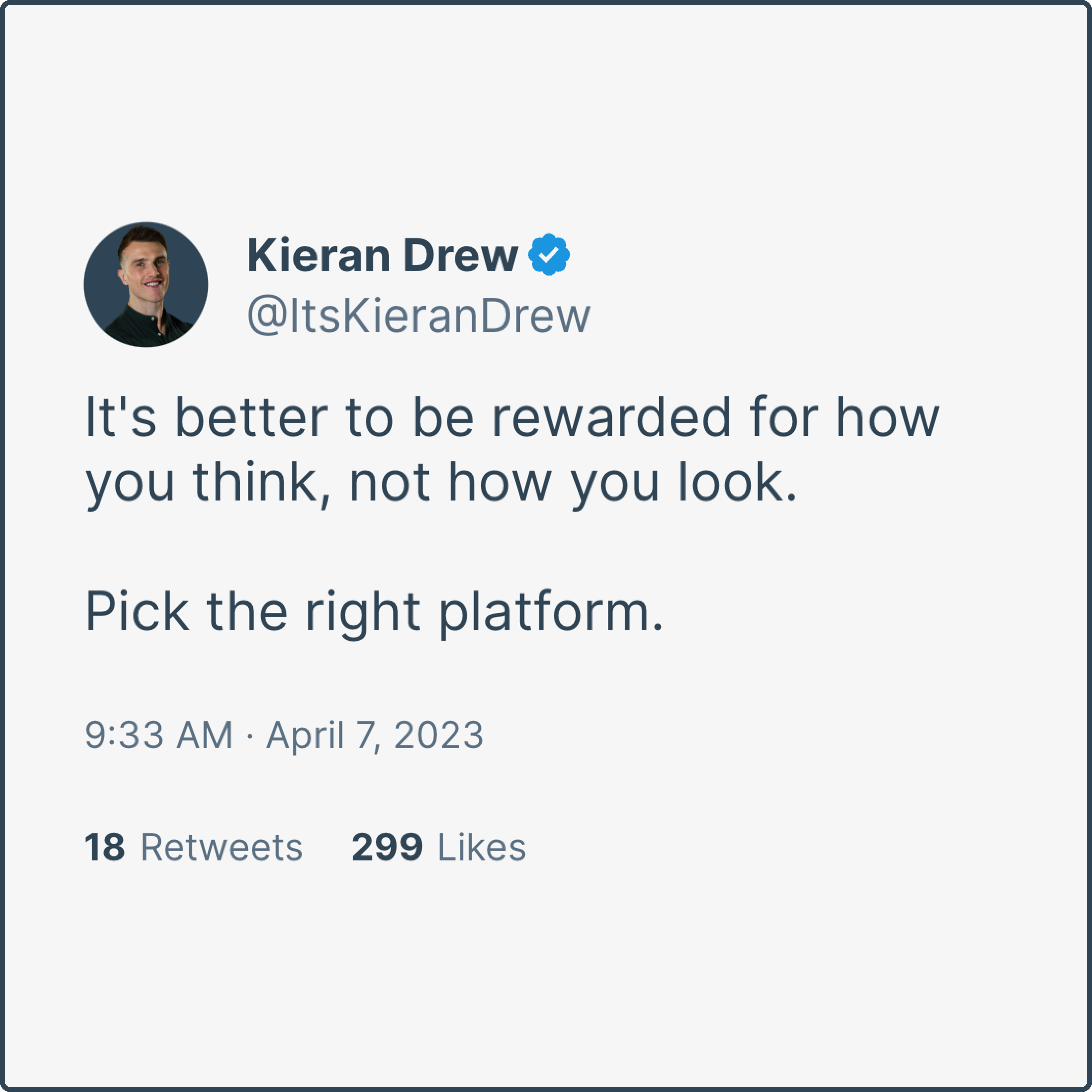
Choosing your topic
If you're not careful, you'll spend endless evenings wrestling with your niche. Trust me on this: it’s as pointless as trying to predict the English weather. Your niche isn't a one-time decision; it’s a constant evolution. The best thing you can do is get to work and see what emerges.
You might already have expertise that you enjoy speaking about. This makes the decision simple. Share what you know and who you are. But if you’re not passionate about your career, one of the best parts about the internet is that you can change your identity.
To do that, you need a slightly different approach.
FOLLOWING YOUR CURIOSITY
Following your genuine intellectual curiosity is a better foundation for a career than following whatever is making money right now.
- Naval Ravikant
Credibility certainly makes the start easier. But the best predictor for long-term online success is curiosity.
Why?
Because the best way to create something exciting is to write about what excites you— emotion seeps through into the page. For example, if I wrote an essay on dentistry, reading it would be as painful as pulling teeth (if you can excuse the pun).
Plus, the start of writing online sucks. No one reads and no one cares. If you love the topic before people pay attention, you’ll be unstoppable when they do.
Some questions to consider:
- What content do you consume for fun?
- Why do people come to you for advice?
- What are the topics you can’t stop thinking about?
- What are the ideas you love to discuss with your friends?
- What skill feels like play to you but looks like work to others?
List the answers, and then use your curiosity as a filter: What interests you most? Try to narrow down to 1-3 topics. Don't worry if this is tough; you're not getting married to the topic. We just need a starting point. The rest happens on the battlefield.
I'll explain how to approach content in a moment, but first, let's talk about your reader.
Your One True Fan
I wish someone told me this sooner: If you try to write to everyone, you write to no one. Sure, you can hack your way to a large audience through generic content, but not all attention is created equal.
The aim is to create fans, and the secret is specificity.
You need to focus on the smallest group of people you can help the most. Kevin Kelly calls this group 1,000 True Fans. Seth Godin calls it Minimum Viable Audience.
To keep things simple, let's call it our tribe.
You build a tribe one fan at a time, and you create a fan by being useful and unique. This means giving actionable advice, sharing stories and having an interesting point of view — the three pillars of magnetic writing.

It's hard to measure if you're creating fans. A good sign you're on the right path is if your audience says:
- “Yes, this is precisely how I feel!”
- “Finally, someone said it!”
- “Wow, this is useful!”
But most importantly:
“I feel like this person gets me.”
To create these emotions, write to one person — your One True Fan. Make it your mission to help them win and ignore everyone else. Show you care about their success, and they’ll care about yours.
The writer who understands their reader the most wins. And the person you understand the most? Yourself. Share the ideas you wish existed when you started. Turn everything you learn today into content for tomorrow. This makes your audience an extension of yourself — a great position to be in.
PROGRESSING TO PHASE 2
Unfortunately, I can’t promise any shortcuts. But I can suggest ideas to make the journey faster (and more enjoyable). We’ll finish each phase with three strategies I've found useful.
1. Be a Reporter
Writing online is the art of selling ideas, and people are skeptical. They only buy once they trust you can help. If you're new to content, the quickest way to earn this trust is to position yourself as a reporter.
Let me explain how it works.
First, you report what you’re learning (using other people’s reputations to build your own — the authority by association technique).

Then, you build in public by sharing your results as they roll in. This approach has a snowball effect. Few people will care about your early wins. But the more progress you make, the more people pay attention. And the more they pay attention, the more progress you'll make.

But nothing will accelerate your business like reporting on your client results. Social proof is incredibly powerful. If you want to be a trusted voice in your niche, show how you contribute to it (we discuss finding clients in the next phase).
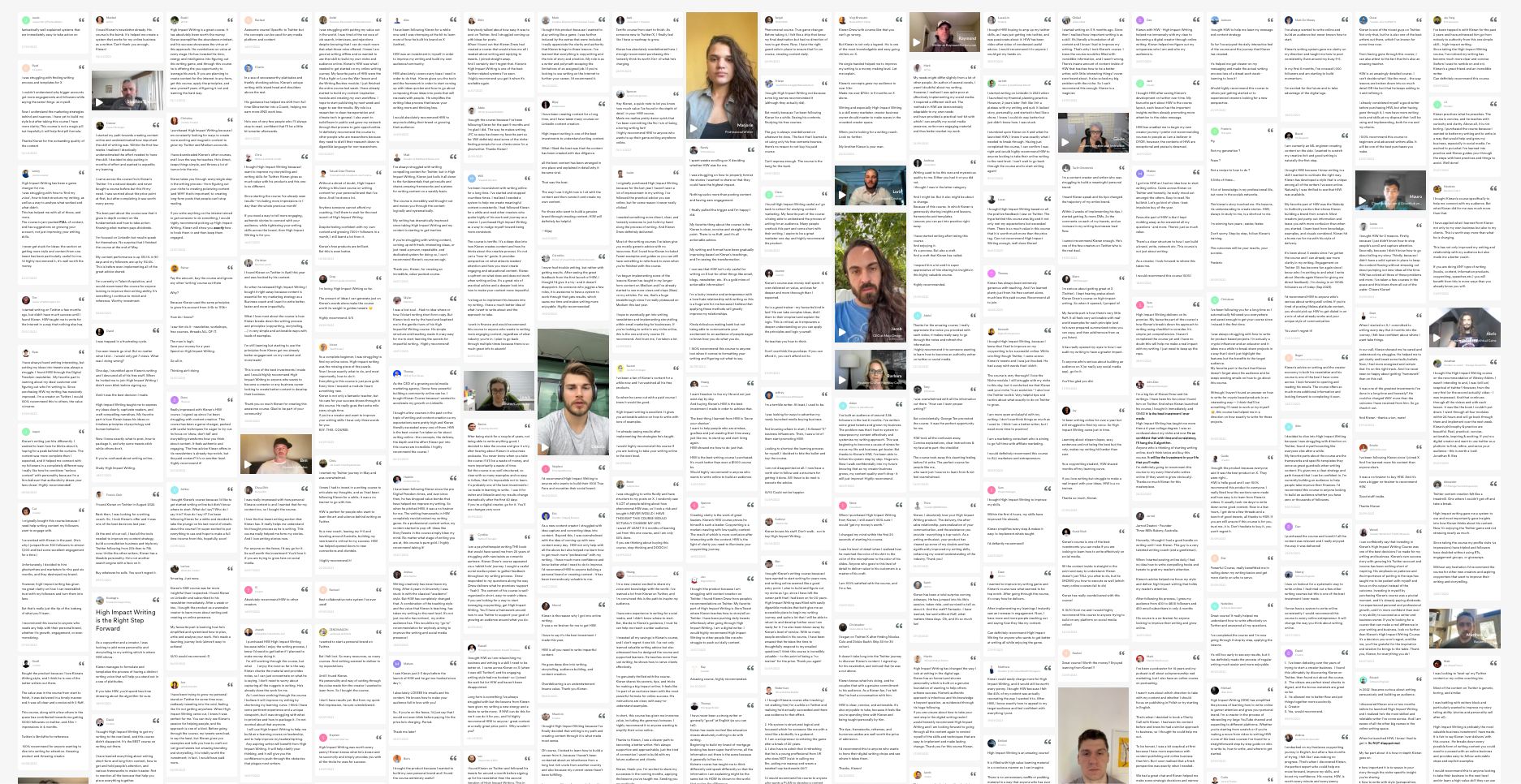
2. Begin broad, then dig deep
One advantage of being an early creator is your ability to pivot. I’d have a tough time writing about salsa dancing tomorrow morning, but you can test topics fast if you have a small audience. You're a small ship, and small ships are easy to steer.
This nimbleness presents the perfect opportunity to explore.
Test and pay attention to the data. Ask:
- What did my audience enjoy?
- What did I enjoy?
The second question is the most important. For starters, you may not have an audience yet. But even if you did, it’s easy to fall victim to the dark side of data — cater to the crowd and you'll soon join it.
When you find a topic you love, go deeper than anyone else. People pay attention to obsession.
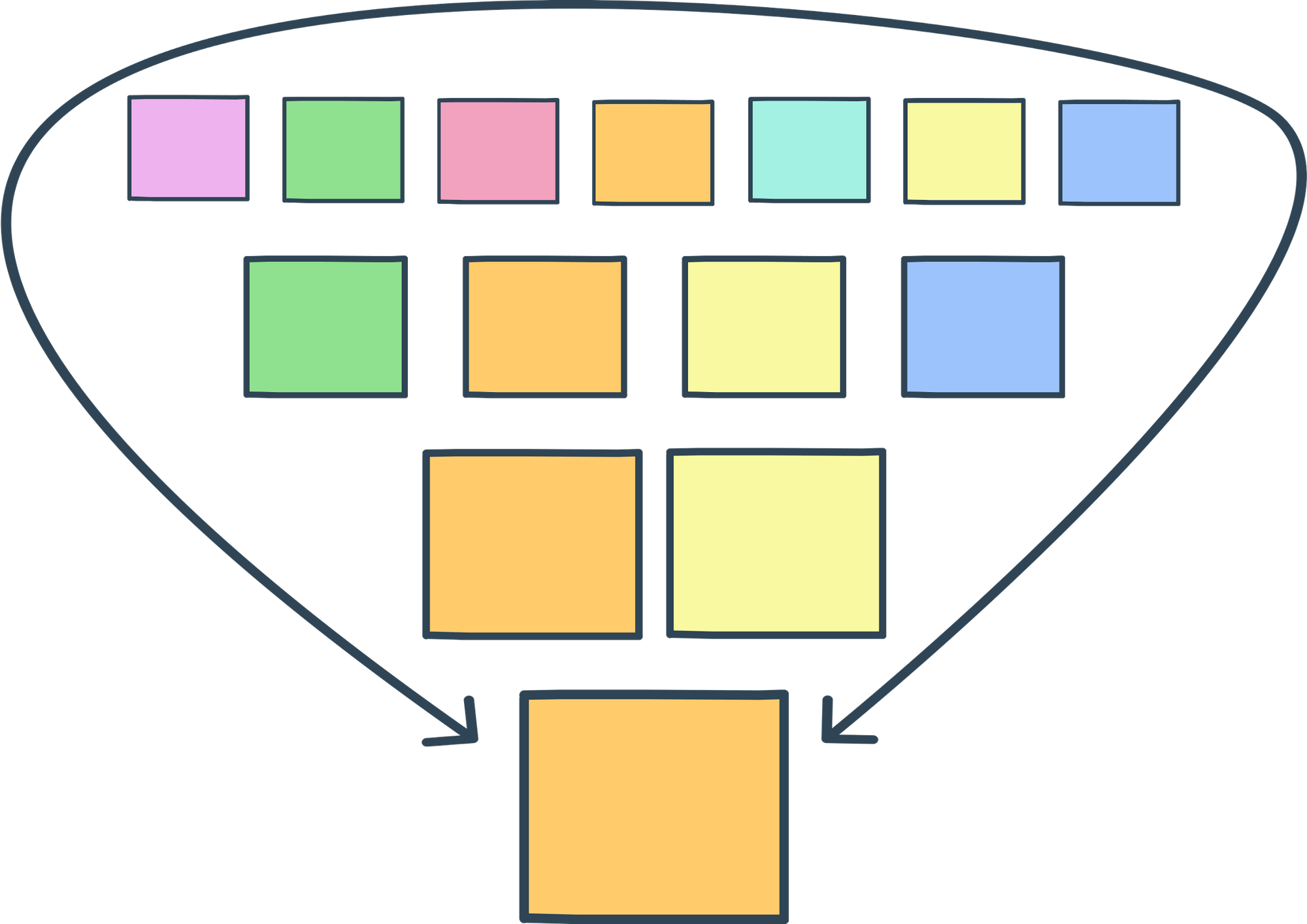
3. Play games you can win
The internet’s a rollercoaster of ups and downs, but unfortunately, at the start — it’s mostly downs.
Your success depends on surviving what Seth Godin calls The Dip — the early lack of results. The key is to focus on metrics you can control. For example, Nathan Barry, the founder of ConvertKit, has three principles on his office wall:
- Work in public
- Teach everything you know
- Create every day
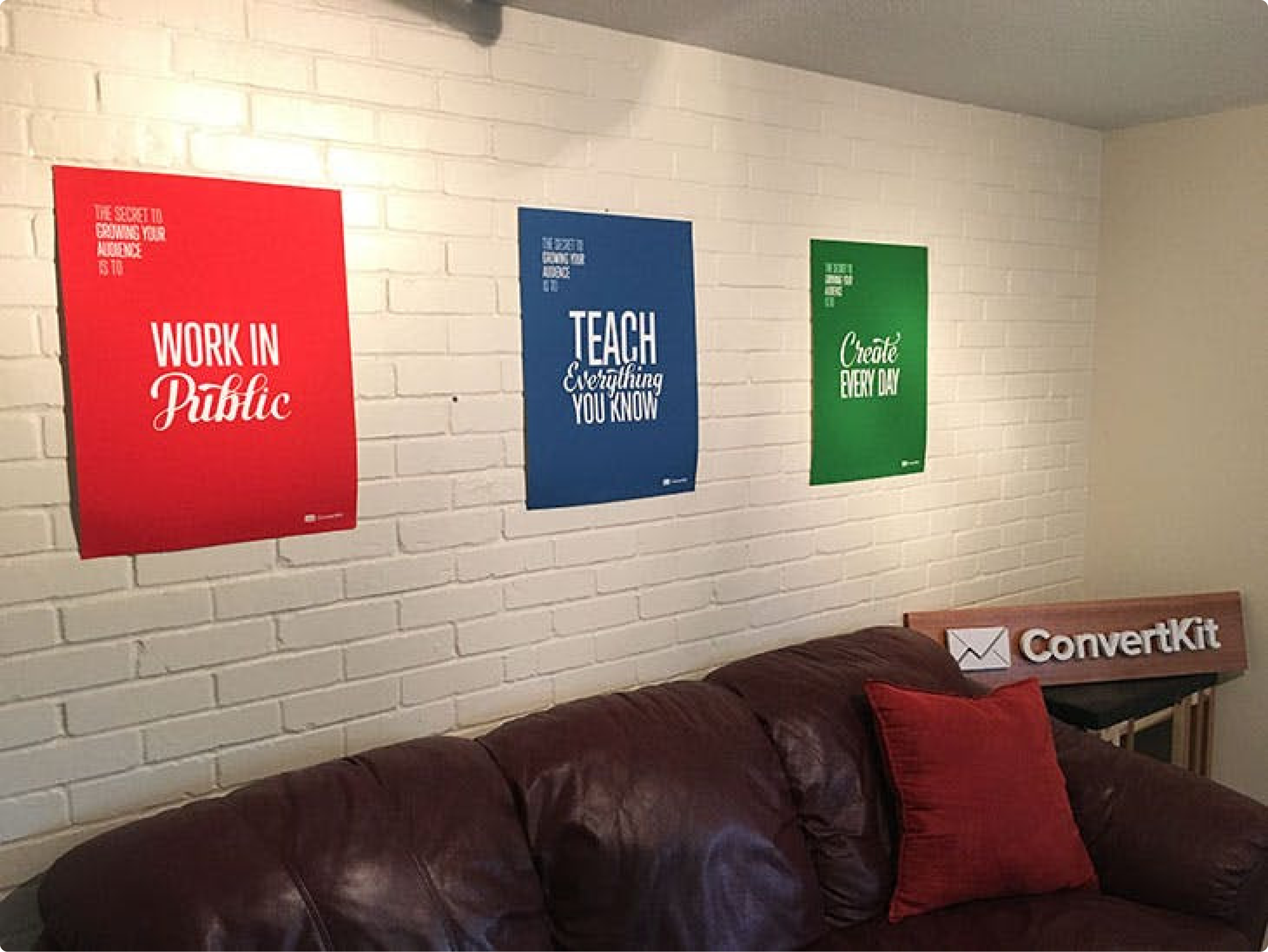
I'll be honest. Occasionally, I stop enjoying myself. Without fail, it’s because I’ve slipped into chasing external metrics (easily done with digital dopamine).
Generally, I ask myself three questions every day:
- Did I improve at my craft?
- Did I learn something new?
- Did I share an idea to help one person win?
Trust me on this. Tactics change fast, but having a good time and being a good person is a strategy that will work for decades.
PHASE 2: EXPERIMENTATION
Now that people are beginning to pay attention, the next step is to get them to pay you money.
Money isn’t the perfect measure of value — but it's a good one. If you can’t get your audience to whip out their wallet, something ain't right (we'll discuss this more over the next two phases).
So let's talk about how to turn your ideas into income.
CHANGING THE SCOPE
Early entrepreneurship isn’t about making stacks of cash. It’s about building momentum.
If you look at every bump in the road through the lens of win and lose, you will have a rough ride, especially when you fail. Instead, the best way to build your business is to treat everything as an experiment. This way, you never fail; you gather data for the next step.
Jay Clouse, the founder of Creator Science, calls this approach experimentality.
“Today's top creators aren't just artists. They're scientists… Instead of relying on best practices, stale tactics, or templates, an experimentality pushes you to run small, controlled experiments to find the truth in the data.”
The aim is to create something valuable and see how the market responds. Most people spend months or years trying to craft the perfect offer. But you don't build it on paper, you build it with people.
You have to put yourself out there to find your thing.
Consider my journey.
Three years ago, if you said I’d have a newsletter-digital product business, I’d have laughed you out of the room. I didn't even know they existed. I only stumbled on it after trying 1-1 coaching, group coaching, ghostwriting, affiliating, advertising, and more.
Like Paul Graham says, “The way to figure out what to work on is by working.”
I’ll explain how to run your first experiment in a moment. But first, let’s dive into your options.
8 popular paths to monetize your writing
There’re countless ways to monetize your writing. The most popular include:
Done For You services
Example: Joshua Lisec
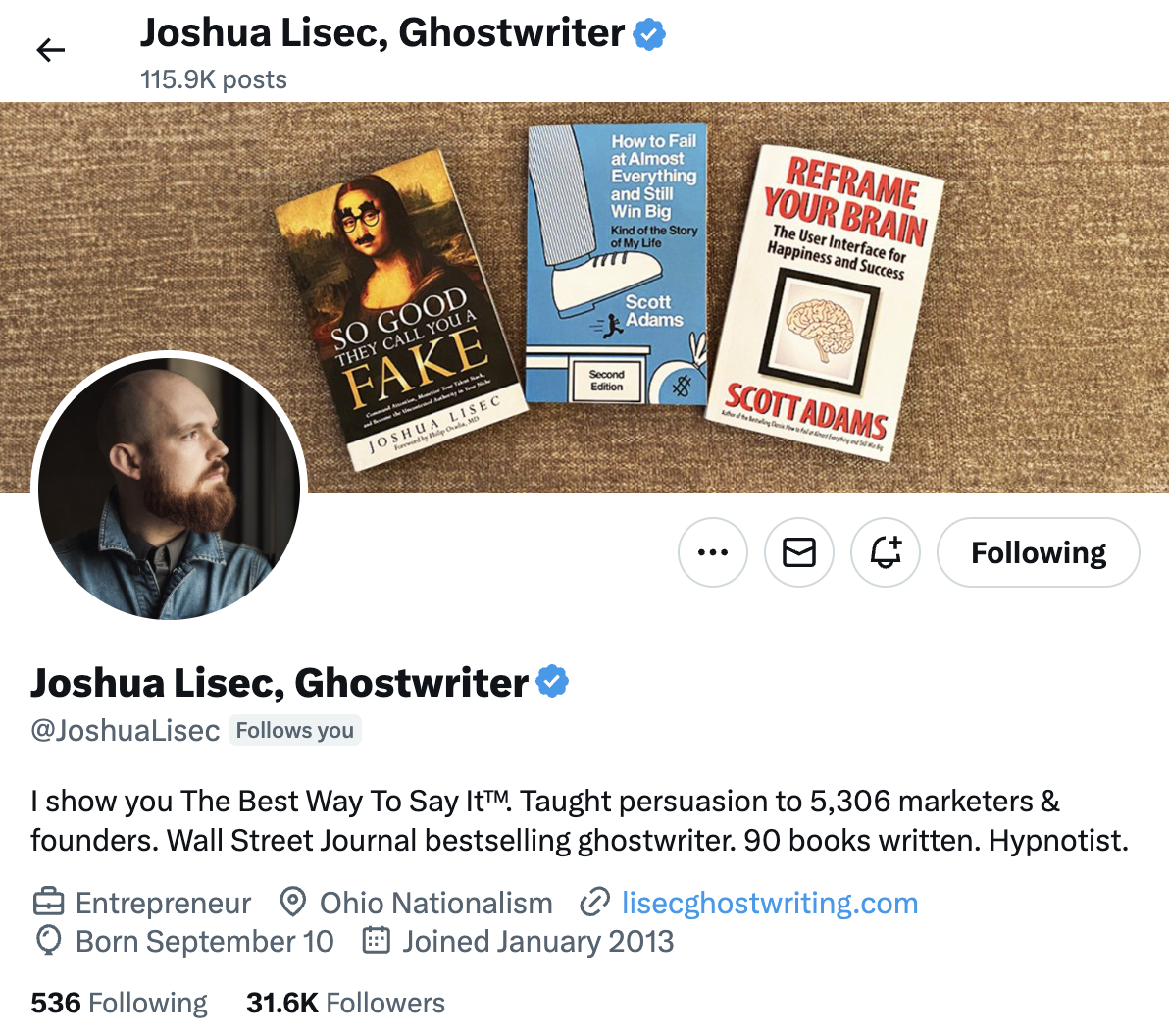
DFY services like ghostwriting are great due to low initial costs and high potential earnings. You might set up an offer like Joshua above and use content to attract business opportunities. Or you could use your online presence as leverage to land a job at a company (if you can write, you'll always be in demand).
The downside to DFY services is scalability — you are the money maker, and you only have two hands.
Long term, you might form an agency, productize your knowledge, or become the best at what you do and charge accordingly.
One-to-one coaching
Example: Dr Julie Gurner’s Elite Performance Coaching
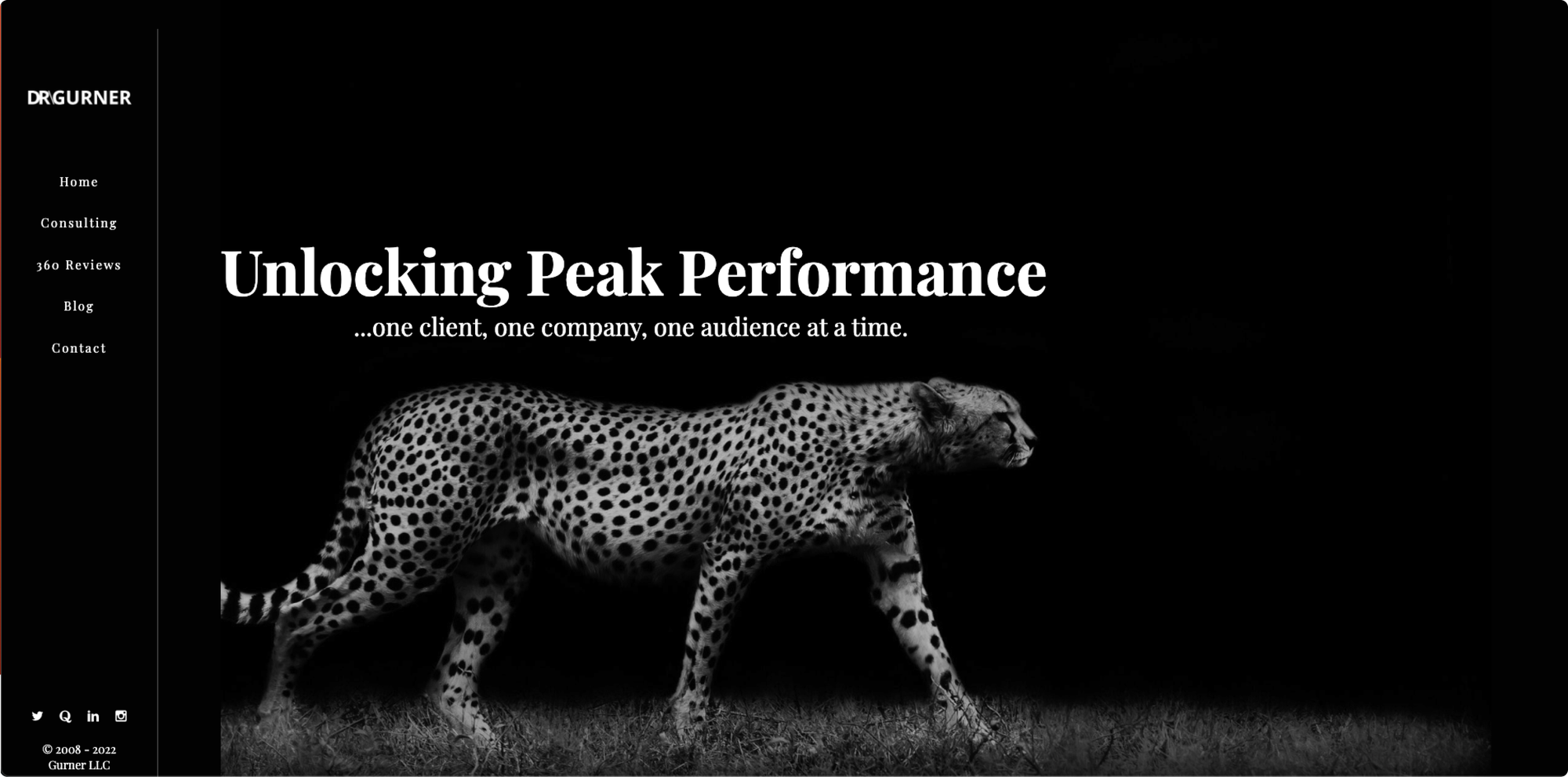
Some people are doers. Others are teachers (you can be both). This is about understanding your strengths. I have friends who moved into teaching because they thought it would make them more money, but hated it and made much less.
Ultimately, the best business to build is the one you’re most excited to work in. I, for one, love teaching. I dived into coaching early (I've explained how I launched my business at the end of this phase).
The benefits and drawbacks of one-to-one coaching are the same as DFY services. High potential, but the minute you stop working, you start losing.
Group coaching
Example: JK Molina’s Tweets and Clients
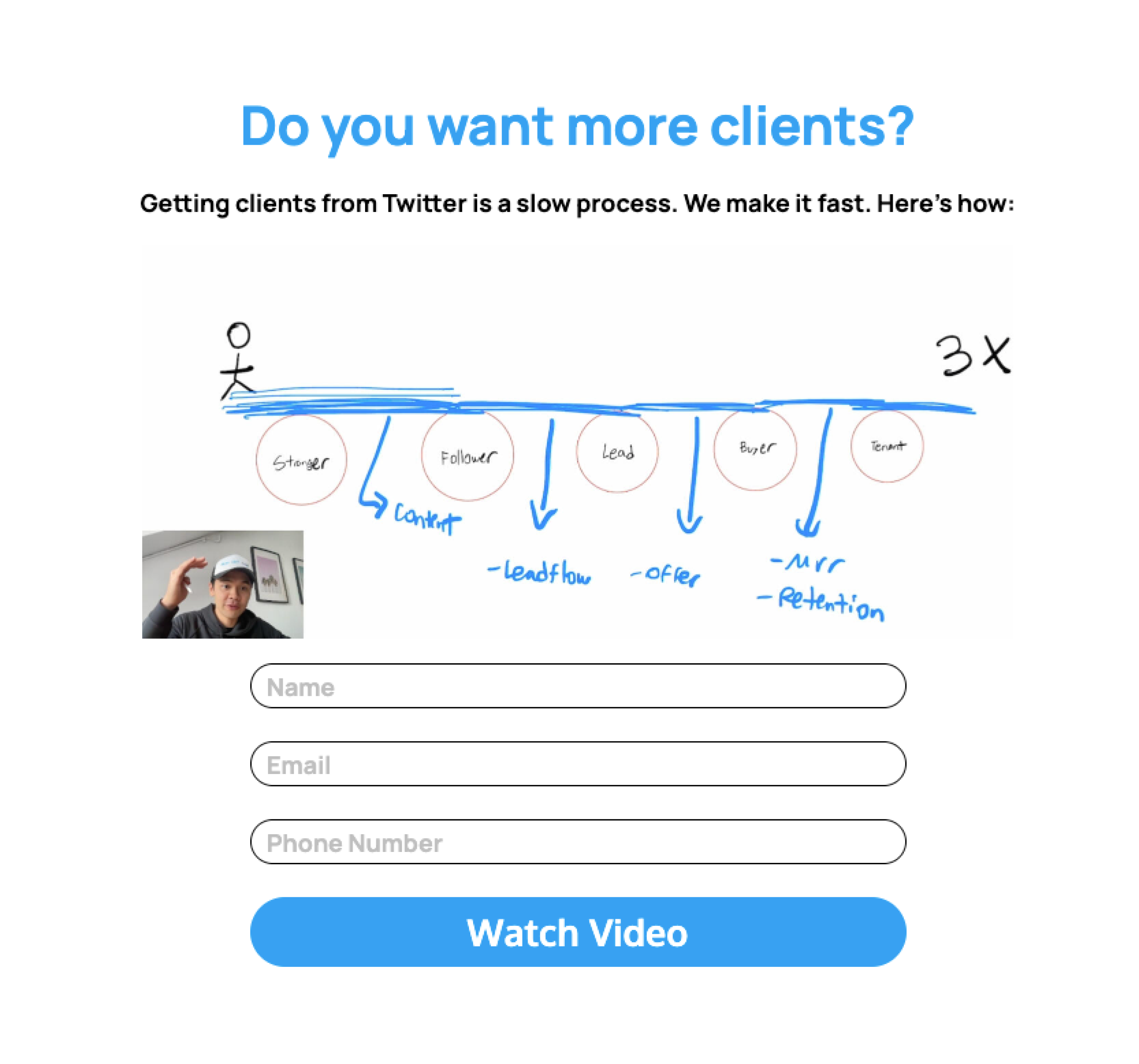
Compared to the DFY and one-to-one offers, group coaching is more ‘leveraged’.
Leverage is a tool to help you achieve more with the same input. For example, as a dentist, I’d work 50 hours a week to treat 50 patients. But as a writer, I spend 5 hours a day to reach 200,000. A keyboard is much more leveraged than a drill.
Group coaching is more responsibility but with more potential rewards.
Digital products
Example: Jack Butcher with Build Once Sell Twice, Visualise Value, and Compound Content
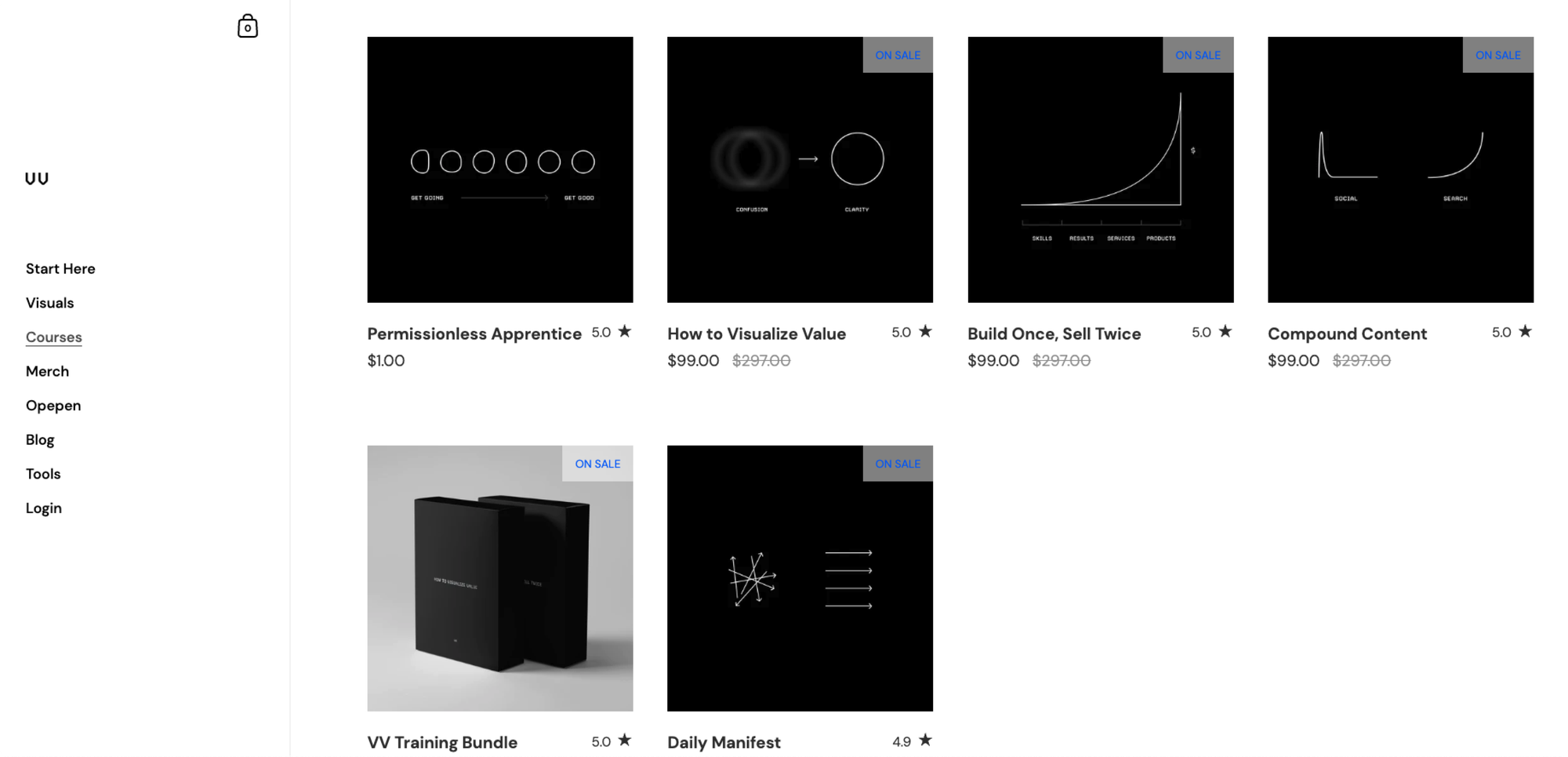
Digital products are high-leverage assets — you build them once and can sell them many times.
The advantage is that more of your audience can access your best ideas. This makes products great for revenue and relationship building. But products aren’t the simple dream most people imagine. They are not passive income. After selling 2,000+ copies of my own, I’ve noticed three downsides.
- Low completion rates. This means you must take product building seriously. There’s no room for bloated concepts or untested systems. If someone is disappointed when they invest, you’ve lost a fan - and potentially thousands of dollars in lifetime value (LTV).
- Product lifespan. You may need to update your ideas often - especially if the product isn’t an evergreen skill. This is less of a problem with coaching, where you can adapt with each client.
- Tough to sell. You need a strong fan base and magnetic writing to build a product business.
Community
Example: Daniel Vassallo’s Small Bets community
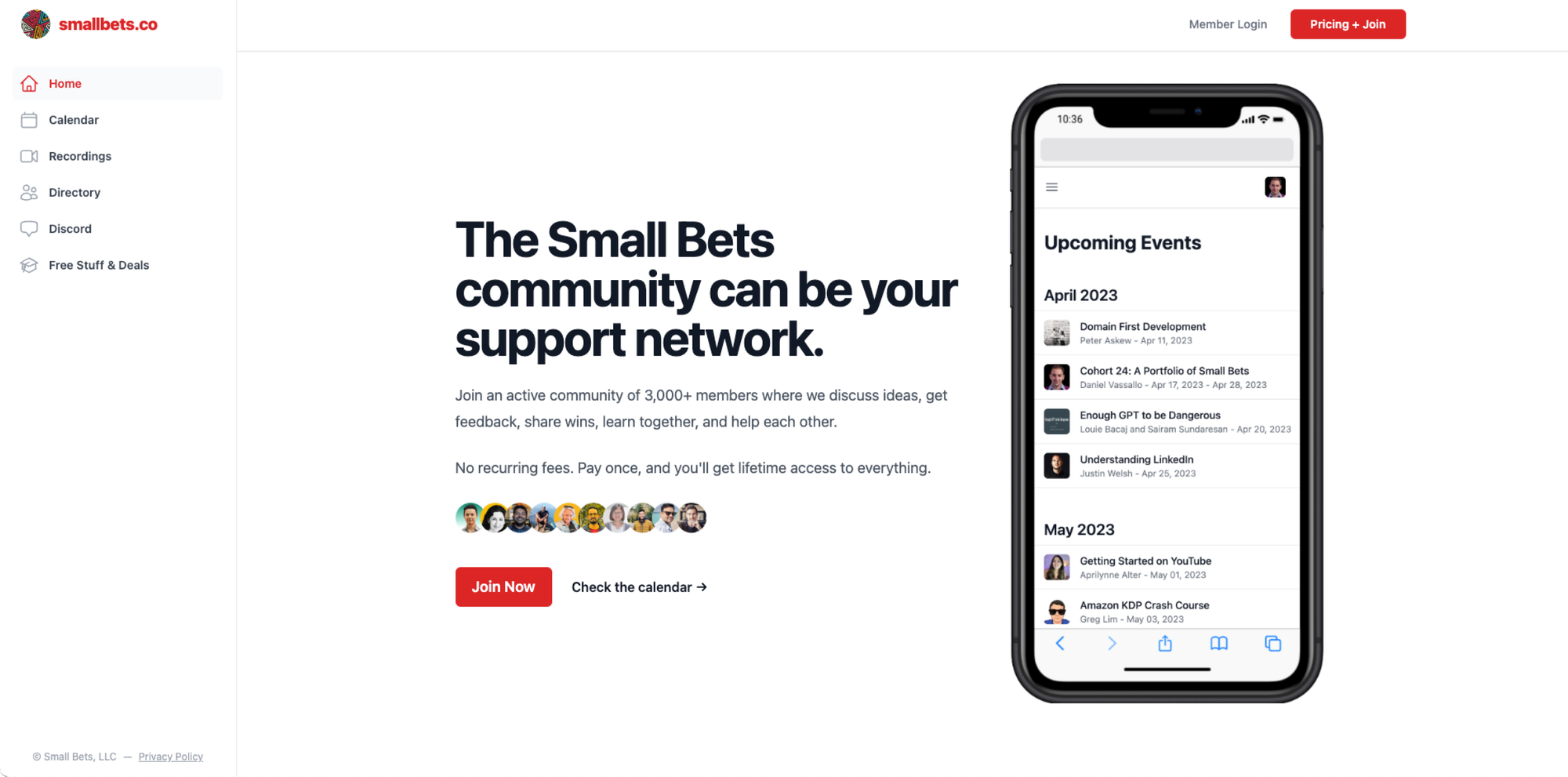
One of our biggest needs is to belong. Uniting people around a common purpose can be a highly profitable, long-term business model.
But a word of warning.
Don’t be blinded by the appeal of monthly recurring revenue (MRR). To build momentum with a community, the upfront investment in time and energy is huge. Then, you have to wrestle with churn. Most creators are better off focusing on easier revenue generators and building a community when they have the resources to do it right.
Cohort-based-courses
Example: David Perell’s Write of Passage
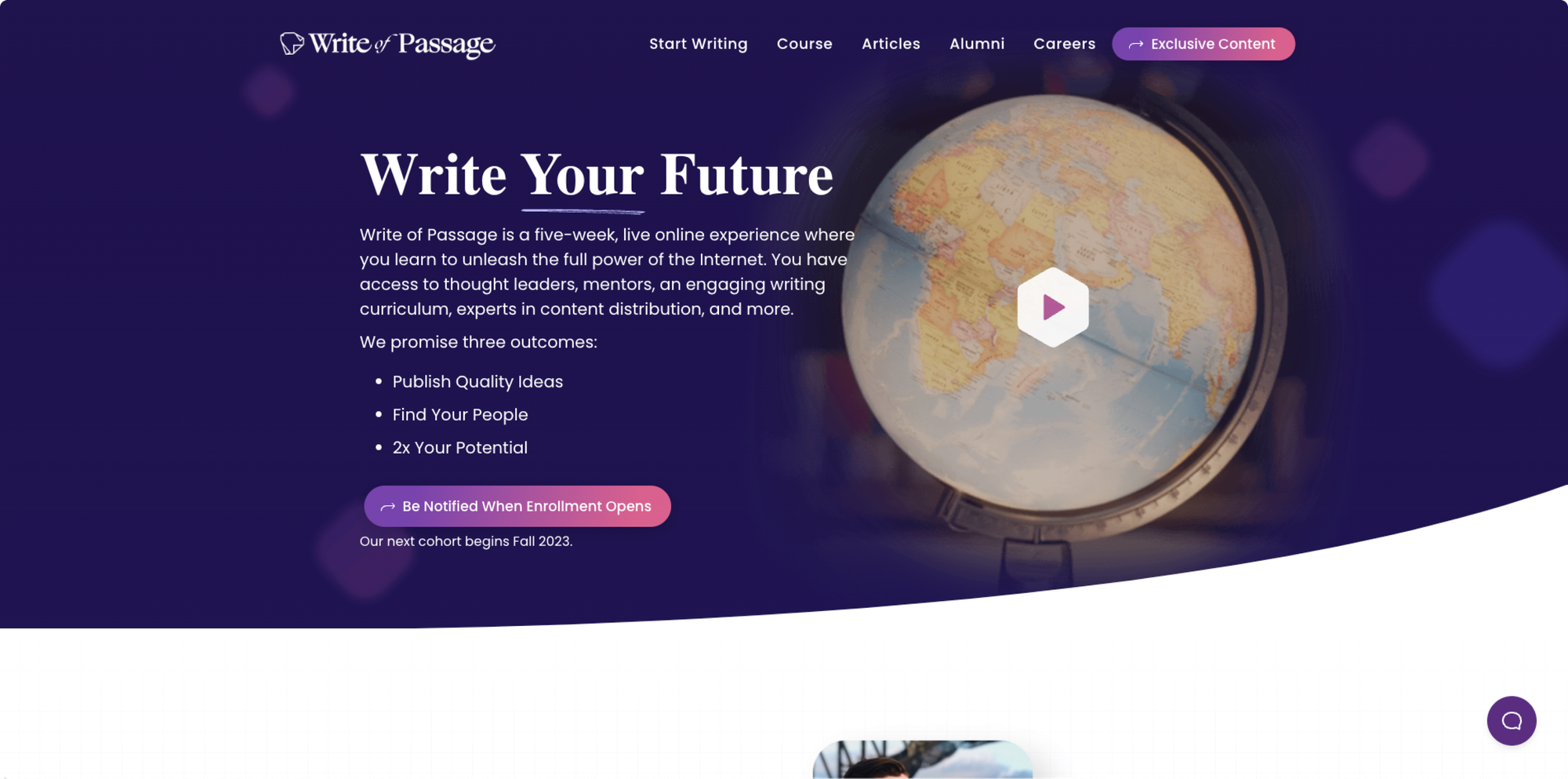
If a course and community had a baby, it would be a cohort.
You get the benefits of both, but unlike community, you don’t have to run it all the time. And unlike products, there's inbuilt urgency for people to buy.
Done well, a cohort is a powerful flywheel. You can improve each round, collect social proof, and scale your prices.
But again, the initial investment in time and energy is high. Don’t start a cohort unless you know you’ll run it several times. It’s the subsequent rounds where the real profit is.
The media/newsletter business
Example: Sahil Bloom’s Curiosity Chronicle
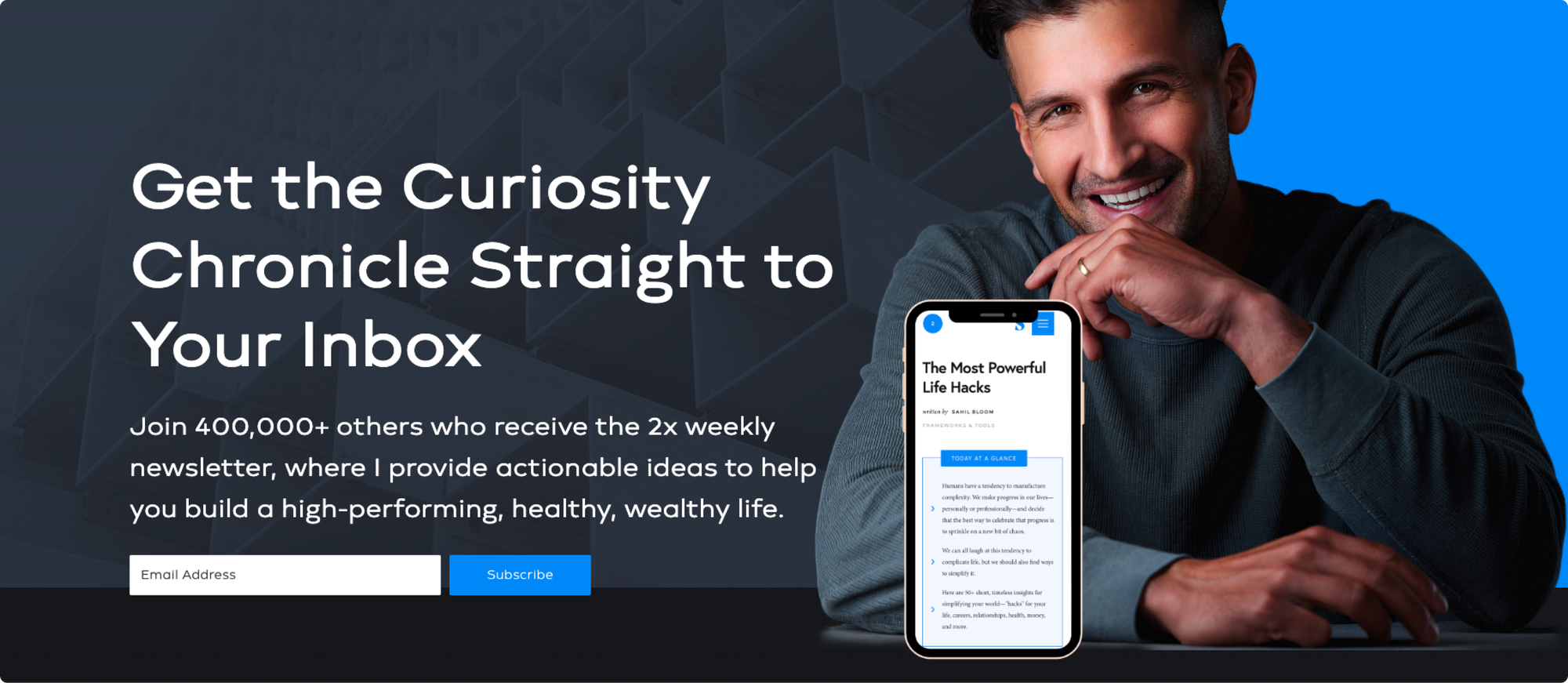
Here, the newsletter is the service — usually monetizing through advertising and affiliating (or charging for the newsletter itself like with Substack).
The media business model is good if you love writing but not building. However, to monetize well, you need either:
- Scale
- Volume
- Specificity (to a high-value audience)
Ideally, a combination of all 3.
For example, you won’t get rich writing a once-a-week newsletter to 500 dental students. But if you write a 3x week newsletter to 5,000 dental practice owners, you could attract the attention of companies selling high ticket offers like $20,000+ equipment or marketing services.
Software as a Service
Example: Nathan Barry’s ConvertKit
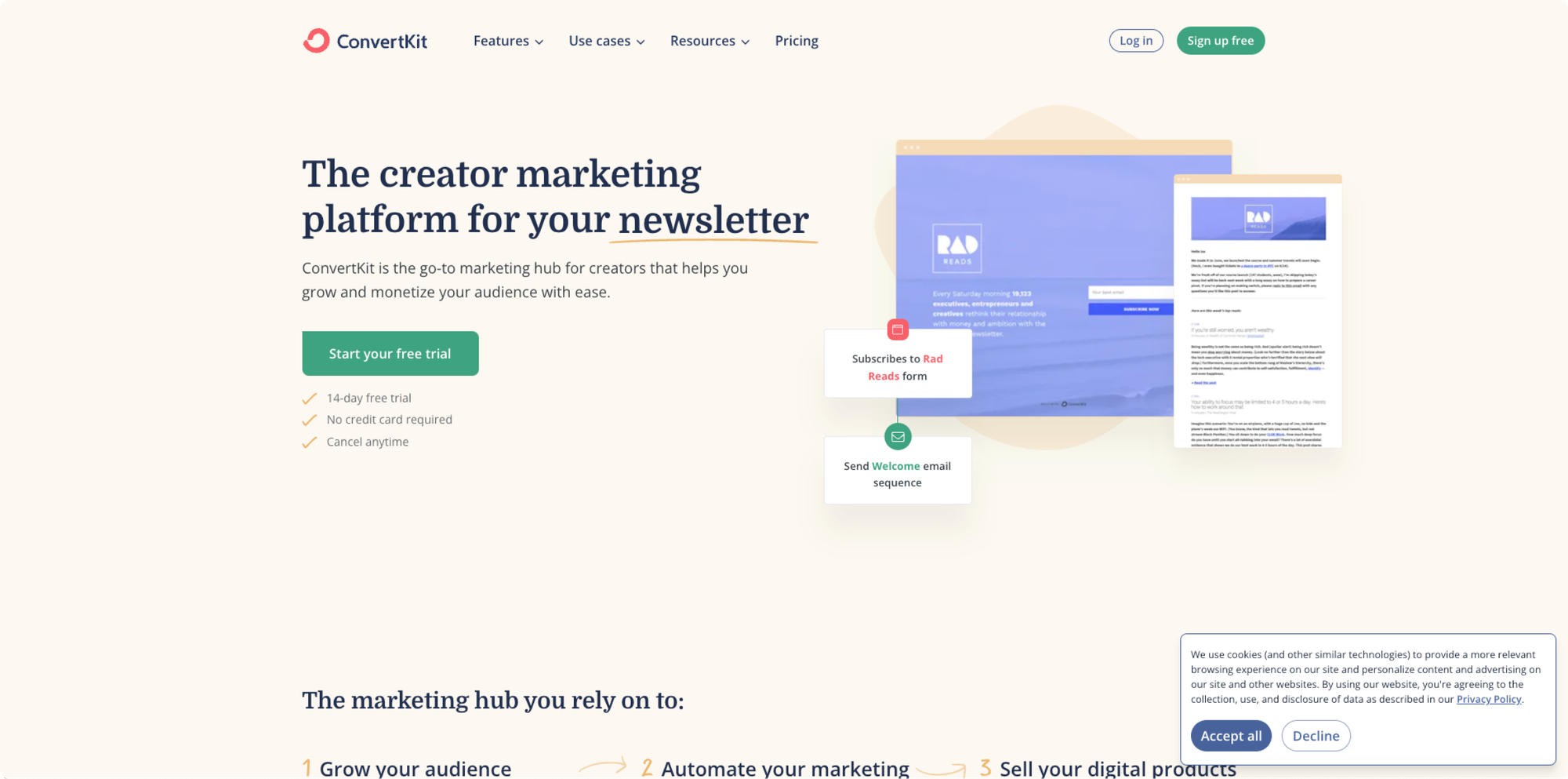
Software is the highest-leveraged option. It’s why Tech dominates the markets — robots don’t get tired.
Software requires specific knowledge to build. Chances are, your circle of competence is content. But keep an eye out for potential collaboration. There are many examples of great businesses emerging from a partnership between a developer and a writer.
Long term, you have the option to combine business models — we’ll discuss a hybrid approach in phase three. But for early execution, focus is everything. Nothing will work if you try to do everything.
Let’s discuss your first experiment.
Your first experiment
You might be tempted to dive into high-leverage offers, but I'd advise you work with people first.
Why? Two reasons.
- If you can’t get one person to pay you, you won't get thousands
- You don't want to spread untested ideas (what's the expression? You can't productize a turd?)
Business is about solving problems. If you find a gap in the market, explore it. For example, if you have a burning passion for Tiddlywinks and no one writes about it like you can, dive in.
Tiddlywinks Tuesdays could be the newsletter the world is waiting for.
Your first experiment should be:
- Offering a DFY service
- Coaching or consulting
To teach, you don't need to be an expert. Most people are looking for guides, not gurus. But you do need experience achieving a result other people want. For this reason, you might begin with a DFY service.
The first step is to narrow your focus.
DIFFERENTIATION THROUGH SPECIALISATION
The mistake people make when selling is that they try to be everything for everyone. Best case scenario, you're a commodity in a competitive market. Worst case, and much more likely, you sell nothing at all.
Think of it like this: You’re getting married in 6 months, and you’re carrying some extra weight. Your wife-to-be has started remarking on your rotundness, so you want a fitness coach.
Who do you pay:
- Coach A. Who helps men and women get fit, build muscle, and lose weight
- Coach B. Who works with overweight men to burn 15lbs of fat with his 90-day ‘bellyblaster’ regime
Specificity creates authority. It makes people think, ‘hey, this is for me!’ — which'll make selling much easier.
You can narrow down in three ways:
- Who you serve
- What problem you solve
- How you solve it (your unique mechanism)
A few examples:
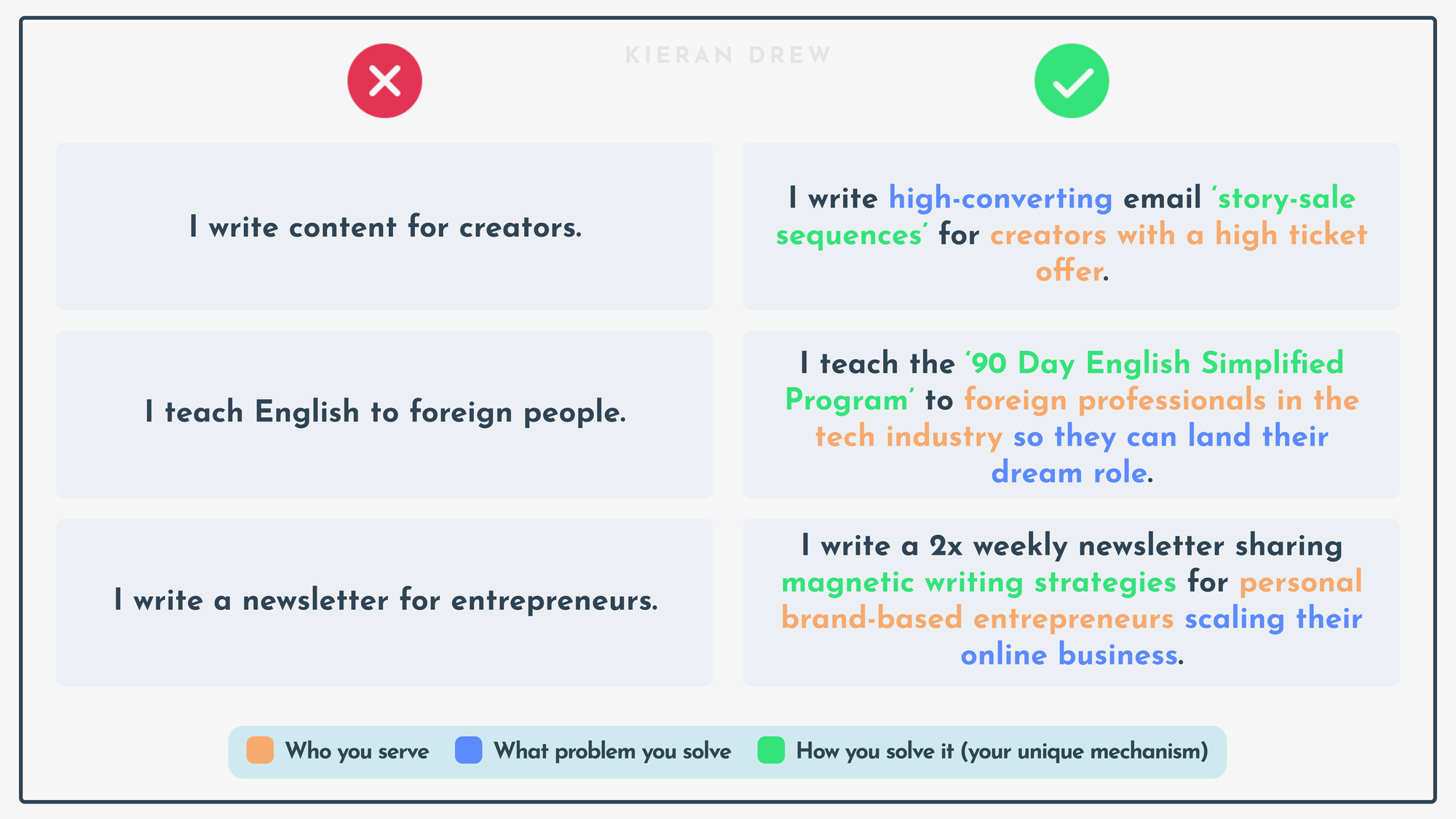
Once you’ve decided your offer, it’s time to put it in front of people.
If you have an engaged audience, reach out to them and frame it as an exciting opportunity to work closely with you for a discounted price.
If you don't have an audience, ask your network or dive into cold outreach. The key is to get your offer in front of people who can afford to pay. For a blueprint on acquiring clients, I'd recommend you check out Alex Hormozi's books on offers and leads.
WHAT HAPPENS WHEN SOMEONE PAYS YOU?
My golden rule for business is to overdeliver at every opportunity. You might not have the expertise of your competition, but you can always outwork them.
For example, I used to sell a 60-minute ‘Clarity Call’. On paper, not much to improve.
But for every client, I:
- Collected a questionnaire and prepared notes
- Messaged the day before to let them know I was excited to meet them
- Had a step-by-step system for every call
- Always ran over by 30 minutes to give ‘unexpected value’
- Wrote a summary report and action plan afterwards
- Offered free help with one thing that came up — for example, if they were going to write a thread, I’d rewrite the hook
- Follow up with a check-in down the line
When I launched my group coaching, all the spots were snapped up — mostly by those who paid for a call. Never underestimate how far going the extra mile will take you.
WHAT HAPPENS IF YOU CAN'T FIND A CLIENT?
Give up. Just kidding. Remember, this is an experiment and now you have data. There's a bottleneck in your business that needs to be fixed. It could be:
- Your outreach method
- Your reputation
- Your avatar
- Your offer
Improve what's holding you back and go again (get a second opinion if you're not sure). Often, it’s just a lack of volume. The world would be a darker place if Edison gave up on the 100th attempt to build a lightbulb.
PROGRESSING TO PHASE 3
1. Aim for minimum viable momentum
I saw a tweet from a popular creator recently that said, “Never work for free. Charge what you’re worth.” I think it's terrible advice. Why? Because the bottleneck is often self-belief — you can’t charge what you’re worth when you think you’re worth nothing.
If you can find a paying client, great.
But if not, start for free.
For example, I began by helping friends with their hooks. I used their results as proof. My first ‘high ticket’ client was $500… for 10 hour-long calls plus writing critiques!
I made sure he did well, and then used his results as proof.
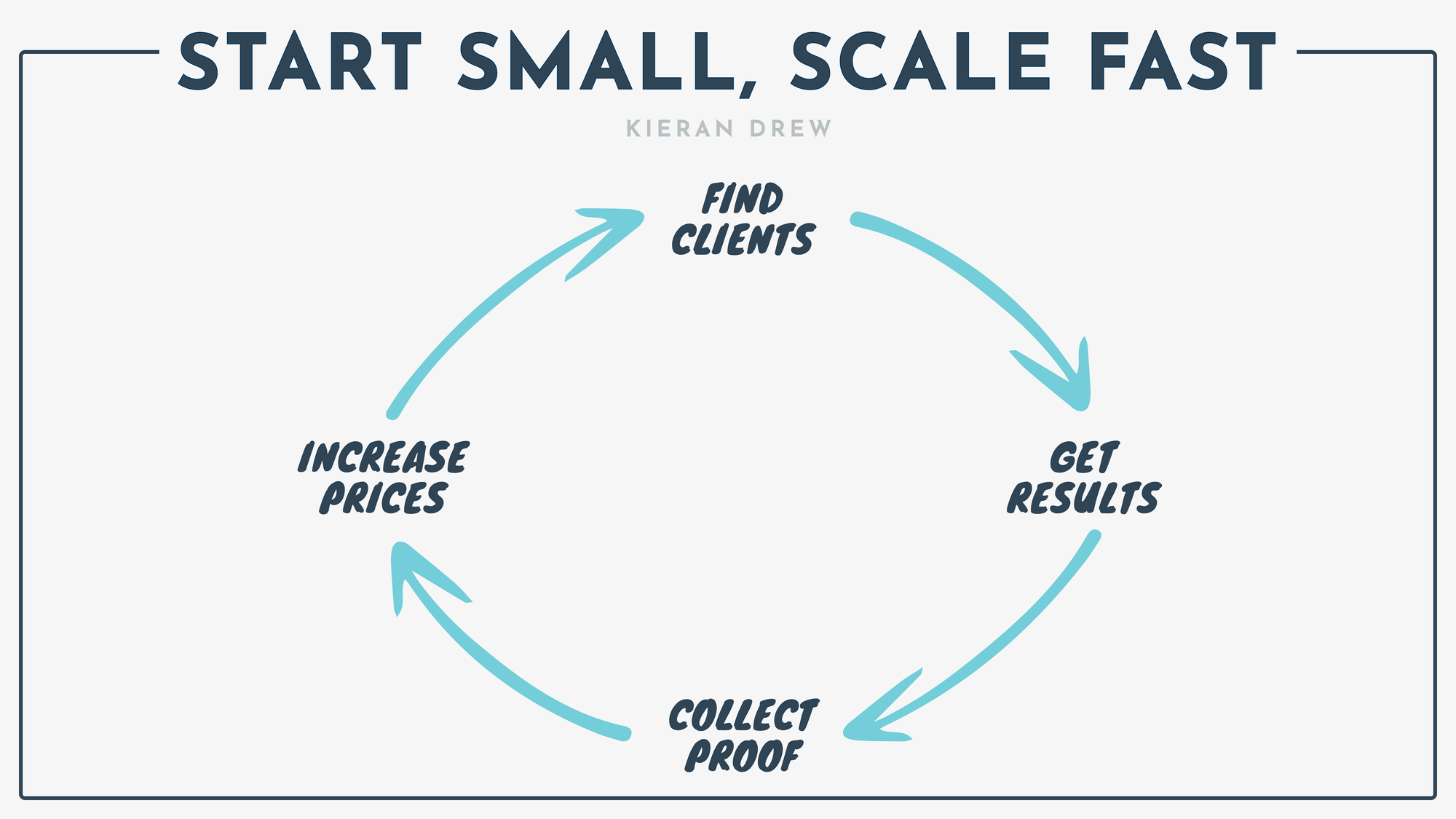
Build your confidence one win at a time.
2. Work in sprints
“Work like a lion. Not a cow.”
- Naval Ravikant
Working in sprints is one of the best ways to stay focused (and sane) as an entrepreneur.
Here's how it works.
Set a goal every 90 days. This is long enough to validate an idea but not too long that you waste your time. For example, your first sprint may be to write 30 long-form social media posts (as a reporter). The next could then be to find a client. The following could be to launch your newsletter.
At the end of each sprint, ask:
- Did I get the result I wanted?
- If not, what can I do differently? Do I want to try again?
- If yes, where do I double down? What's the next smartest step?
3. Experiment with ideas too
We’ve only spoken about monetization. But your income is closely intertwined with the quality of your ideas. The more useful and unique they are, the more people pay attention.
Use social media’s fast feedback loops to test:
- Stories
- Systems
- Blueprints
- Frameworks
- Coined terms
Collect what works and repeat them often. These ideas form your armoury of insights.
PHASE 3: ENTREPRENEURSHIP
Brilliant. You’re making that sweet digital moolah. It’s all uphill from here, right?
Not so fast.
There’s a graveyard of entrepreneurs who fell victim to ‘false starts’ — their business fizzling out like fireworks in the sky. Then you have entrepreneurs who hit an income ceiling or accidentally trade a 40-hour week job for a 60.
Often, the difference between those who succeed and those who stall isn't work ethic, but working on the wrong things. Progressing to six figures and beyond is about good judgement, great systems, and excellent execution.
The 3 components of a writing business
For the next step, I want you to picture your business as a system.
The aim of the system is to turn impact (what you give) into income (what you get).
Every system has moving parts that click together like cogs in a machine. These are the big levers, and there are only three that matter for the business of writing:
- Reach: Your ability to generate traffic
- Relationships: Your ability to earn trust
- Revenue: Your ability to make money
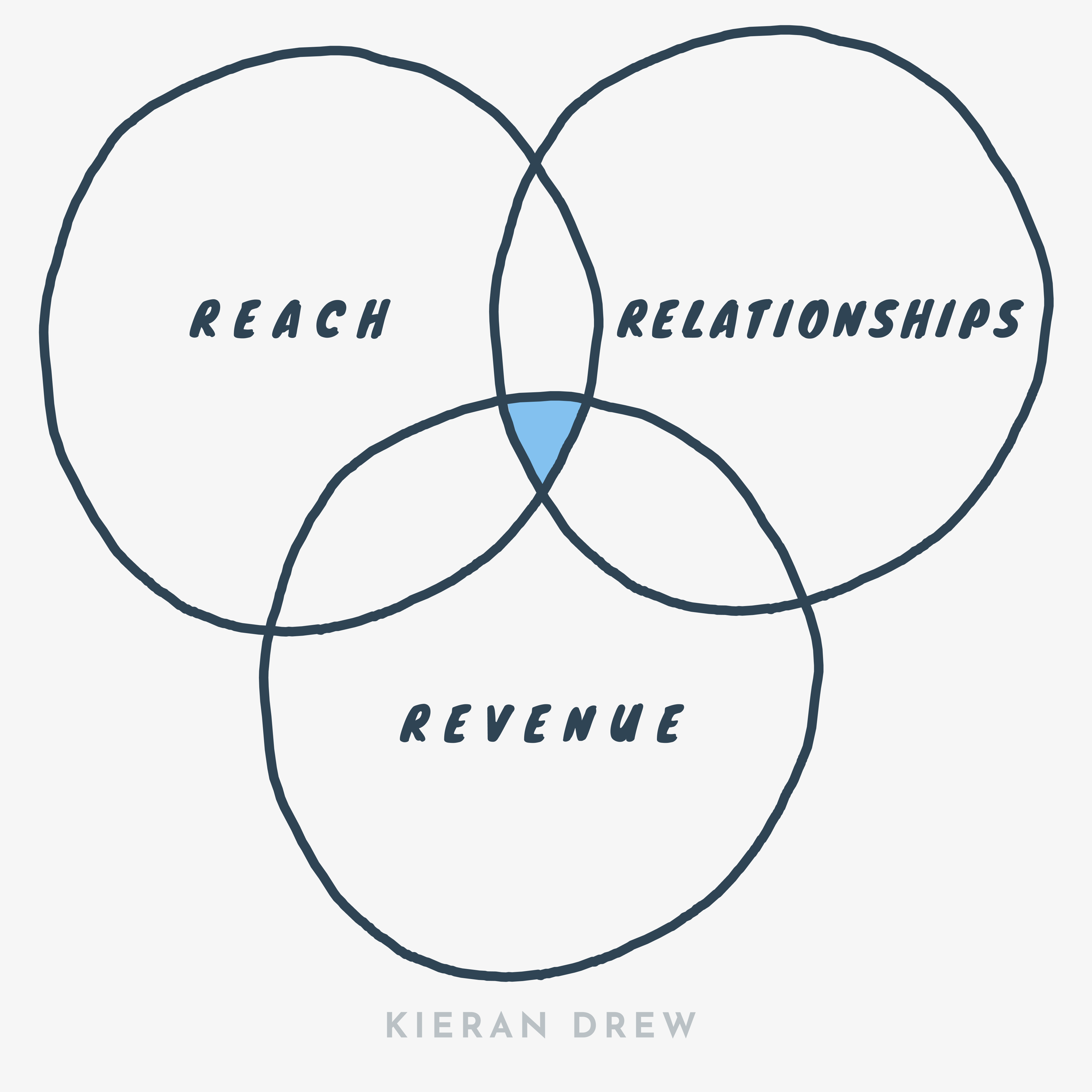
When these cogs operate well, your business grows—sometimes staggeringly fast. But when one runs poorly, the rest of the system suffers. It’s like having a flat tyre—you might be able to move, but not far and certainly not fast.
Charlie Munger once said it’s easier to avoid stupidity than to achieve brilliance. One mistake I've made, and many like me, is trying to build the fanciest business — layering complexity instead of choosing simplicity.
The more levers you add to your business, the more risk of mistakes.
The key is understanding the difference between ‘nice’ and ‘necessary’. Necessary is what you need to build. Nice is what you might use to scale. Focusing on the fundamentals and ignoring shiny objects is now 90% of the work.
Let’s define those fundamentals.
1) REACH
Your system needs an input — a steady supply of traffic.
This might be organic (audience) vs. inorganic (paid acquisition).
Paid acquisition has the benefit of speed, but an audience has the benefit of trust. It’s why we started the essay with content. A following takes time, but it's the most powerful part of your business.
A note: You do not need multiple social media channels to build your business. FOMO will ruin you if you let it. Commit to one platform until you have a working offer. Anything else is a distraction disguised as an opportunity.
2) RELATIONSHIPS
Relationships are the most profitable yet most overlooked component of the writing business. Why? Because it’s easier to chase what we can see. Unlike followers, fans can’t be flexed. Unlike dollars, trust can’t be counted.
“We know the world doesn't need another mediocre commoditized widget for the attention-deprived mass-market. Instead, we're in the relationship business, the human-to-human business of serving and mattering to the few.”
- Shawn Twig & Andre Chaperon, The Modern Marketing System
For relationships, you need a way to build intimacy and connection. As a writer, this is your newsletter. You could argue for a podcast, but there are three reasons email should be your top priority:
- You own your email list
- Email marketing is incredible for revenue
- You can use your newsletter to promote other projects (like your podcast)
To grow your list, plug your newsletter under your social media content every day. If you don’t promote yourself, no one else will. My list is now a 7 figure asset, and I grew 95% of it for free.
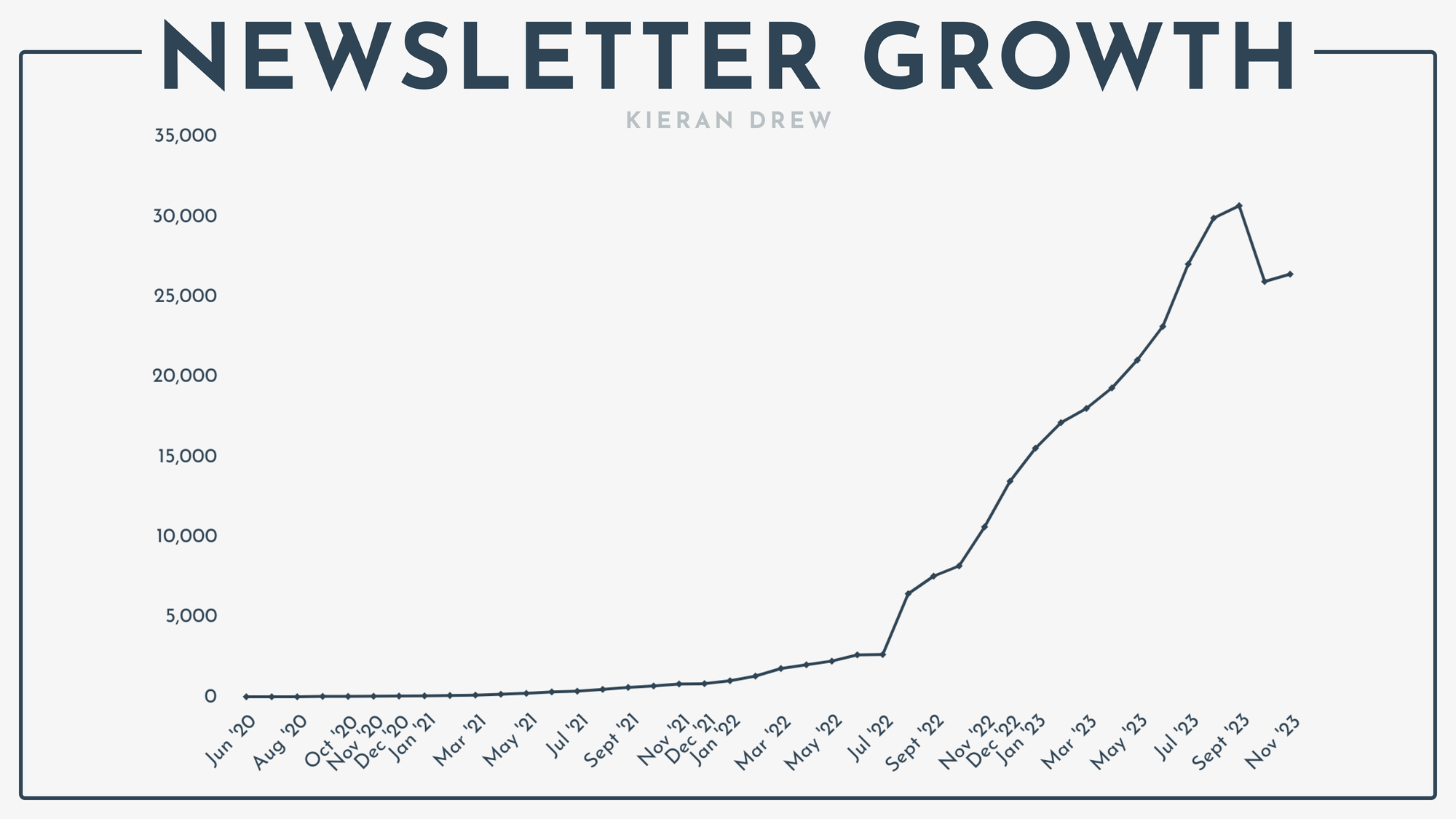
At a minimum, send one weekly newsletter to your list.
How much and what to write is up to you. I'd advise you spend most of your time on social media to get momentum and gather data, then gradually prioritise your newsletter to convert followers to fans.
The ‘Idea to Insight’ flywheel is useful. Use fast feedback loops to test ideas with social media and then expand the best into emails. You can then turn emails into more social media content.
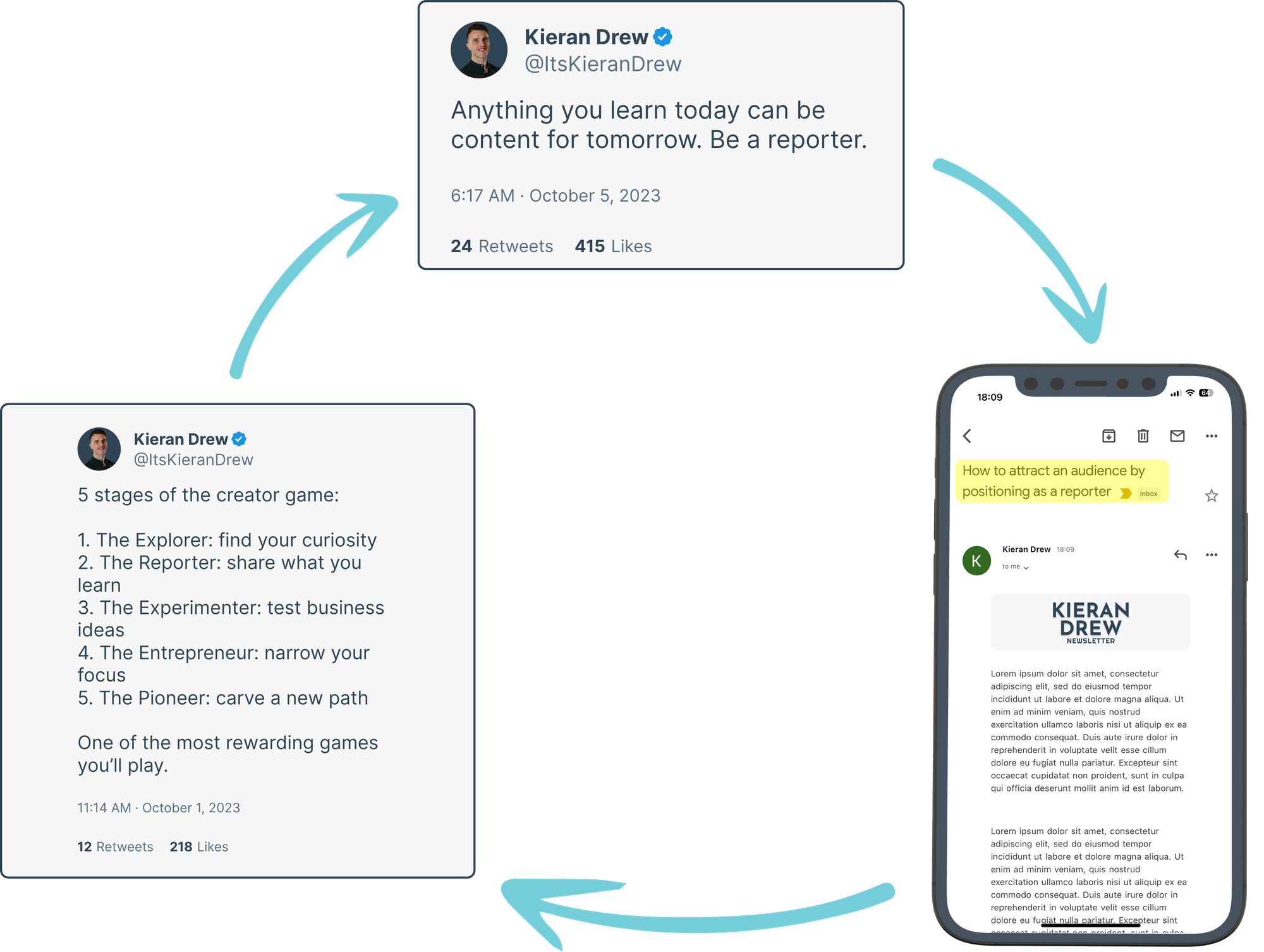
In addition to a newsletter, consider building at least one authority asset (like this essay) to accelerate relationships.
3) REVENUE
I see many creators build offers and then quickly move on to the next, but that’s like running a marathon and stopping at the final few miles.
It's better to have one smash-hit offer instead of 5 average ones. You want:
- Product market fit
- Great client results for social proof and word-of-mouth marketing (and a system to spread it)
- A smooth delivery system (automation and perhaps a team for customer support)
- A well-oiled sales system (an excellent sales page, email sequence, order bumps, upsells and/or downsells)
90% of this can be automated, delegated, and systemised. By slowing down and doing things right, you can go much further long-term.
Execution
Let’s touch base.
Your mission as an early entrepreneur is to:
- Become an authority on one platform
- Start a newsletter
- Scale an offer
Here’s where the path splits.
Unfortunately, business is not a one-size-fits-all prescription. You must understand your current position and allocate energy according to what needs to be fixed. For example, if you have an offer but no audience, double down on content. But if you have a big audience and a terrible offer, writing more long-form content is not a smart decision.
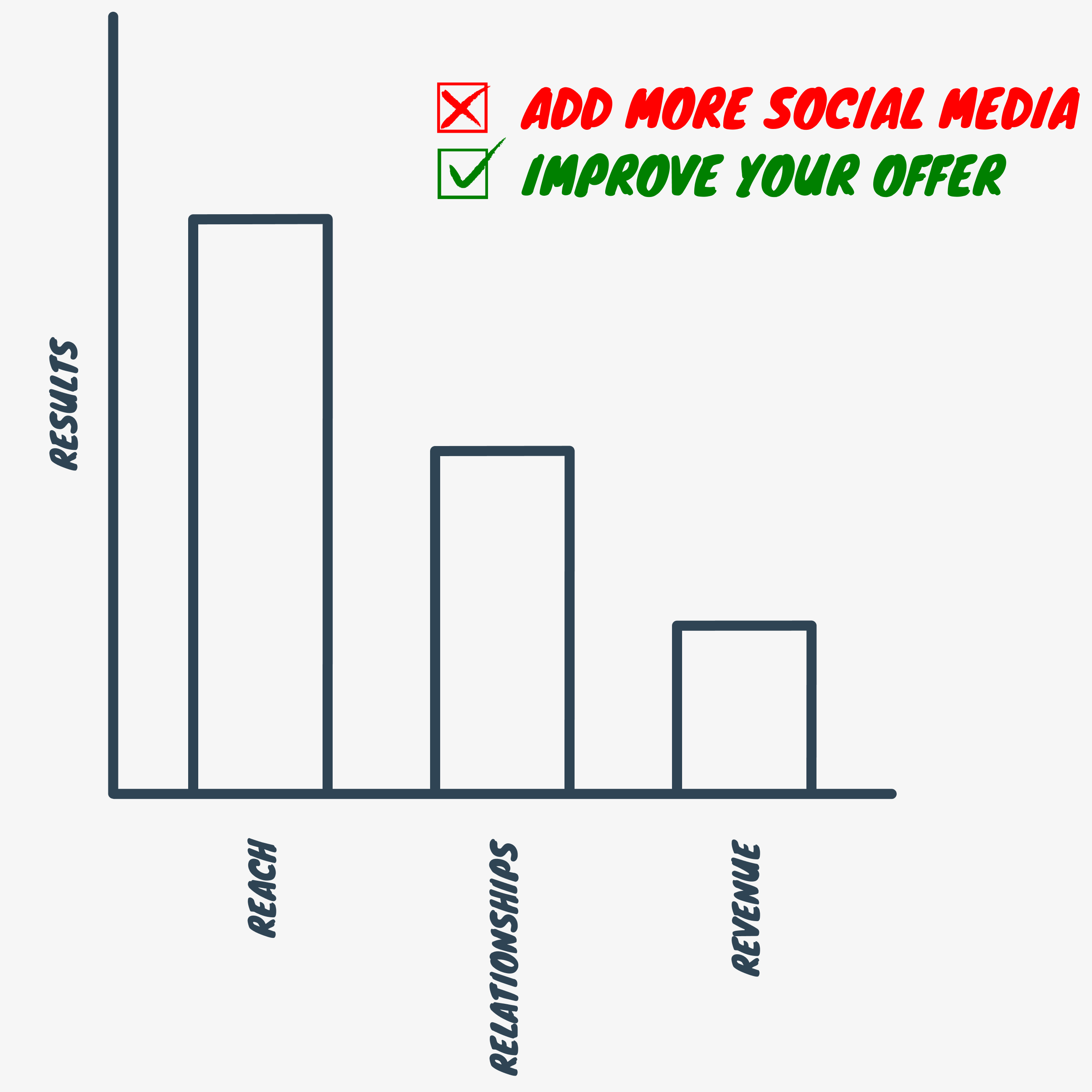
A word of caution: We often default to our strengths instead of focusing on our weaknesses. It’s easier to do more of what we’re good at than face what we’re not. This blind spot is a problem.
An example from my journey:
At the start of 2023, I was hitting $10k/month but struggling to scale further. When I looked at my time and energy allocation, it was clear I cared about writing. Nothing else mattered except getting good.
What I didn’t appreciate is that, by external standards, I was already there.
Think back to our system. I was investing heavily into going from a B to an A in reach and relationships when my revenue cog was sitting at a D. I had an average product and no sales system.
So I wrote less and studied more.
In May, I had my first six-figure month. In September, I had my second. In November, I made $80k and launched a monthly recurring offer. It was an intense six months, but I made years of progress by fixing what was lacking.
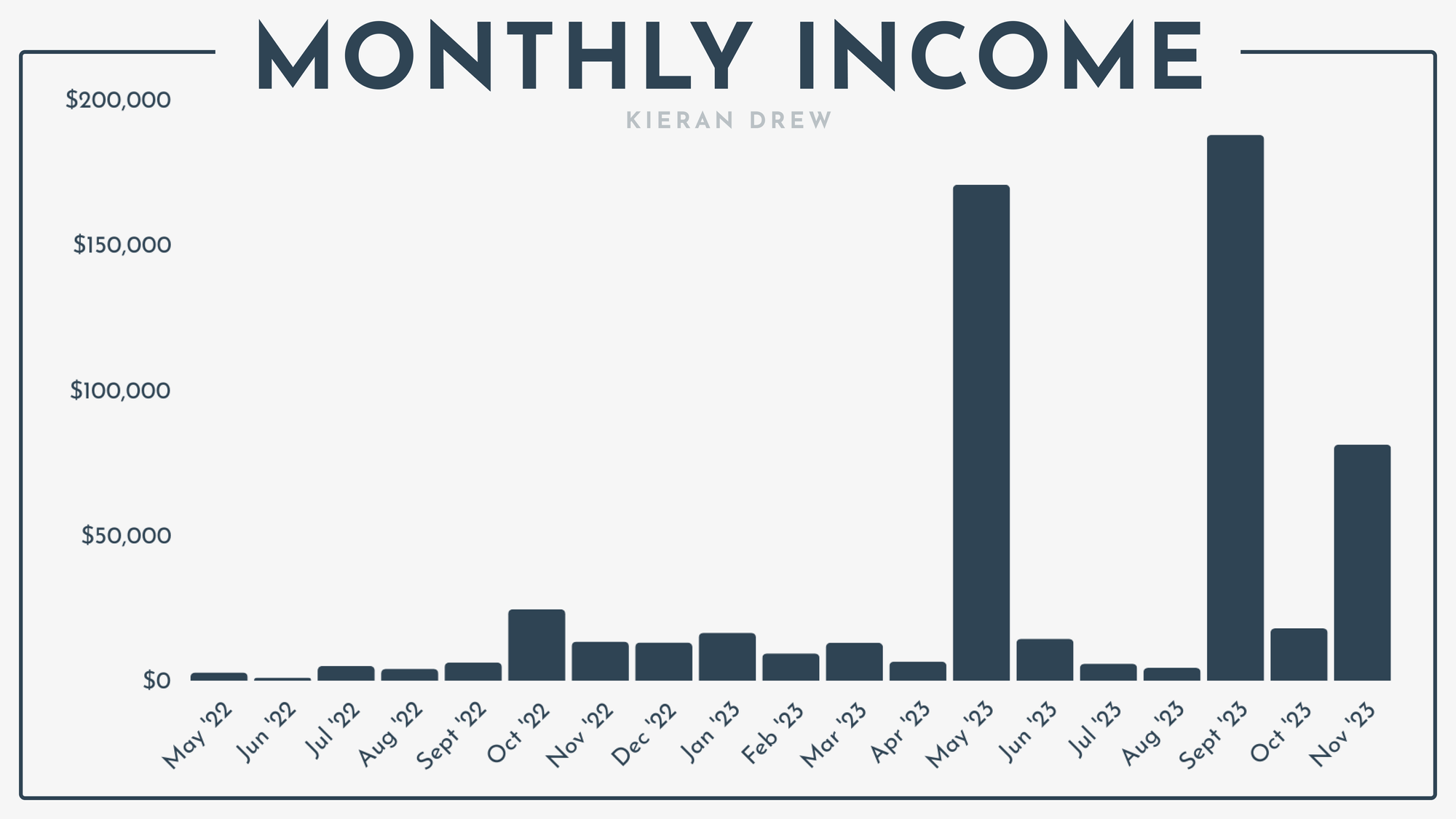
Let’s talk about when systems get exciting (I don't get outside much).
Pouring gasoline on the fire
The benefit of a well-functioning system is that, once established, results go from linear to exponential. It’s not a case of 1+1+1 = 3. It’s more a 1+1+1 = X³ — with X being your income.
At this stage you can add more ‘nice to haves' because every input leads to a much greater output.
Picture this:
You have an audience, newsletter, and offer. You decide to add another social media channel. But now you have a reputation plus a library of content to repurpose.
The second channel grows much faster, with much less time.
As a result, you get more traffic, leading to more email sign-ups. Your newsletter creates more trust, leading to more buyers. More buyers means more fans. And more fans means more advocates for your social media content, leading to more traffic.
You’ve pulled one lever, but every cog spins faster, creating an exponential result.
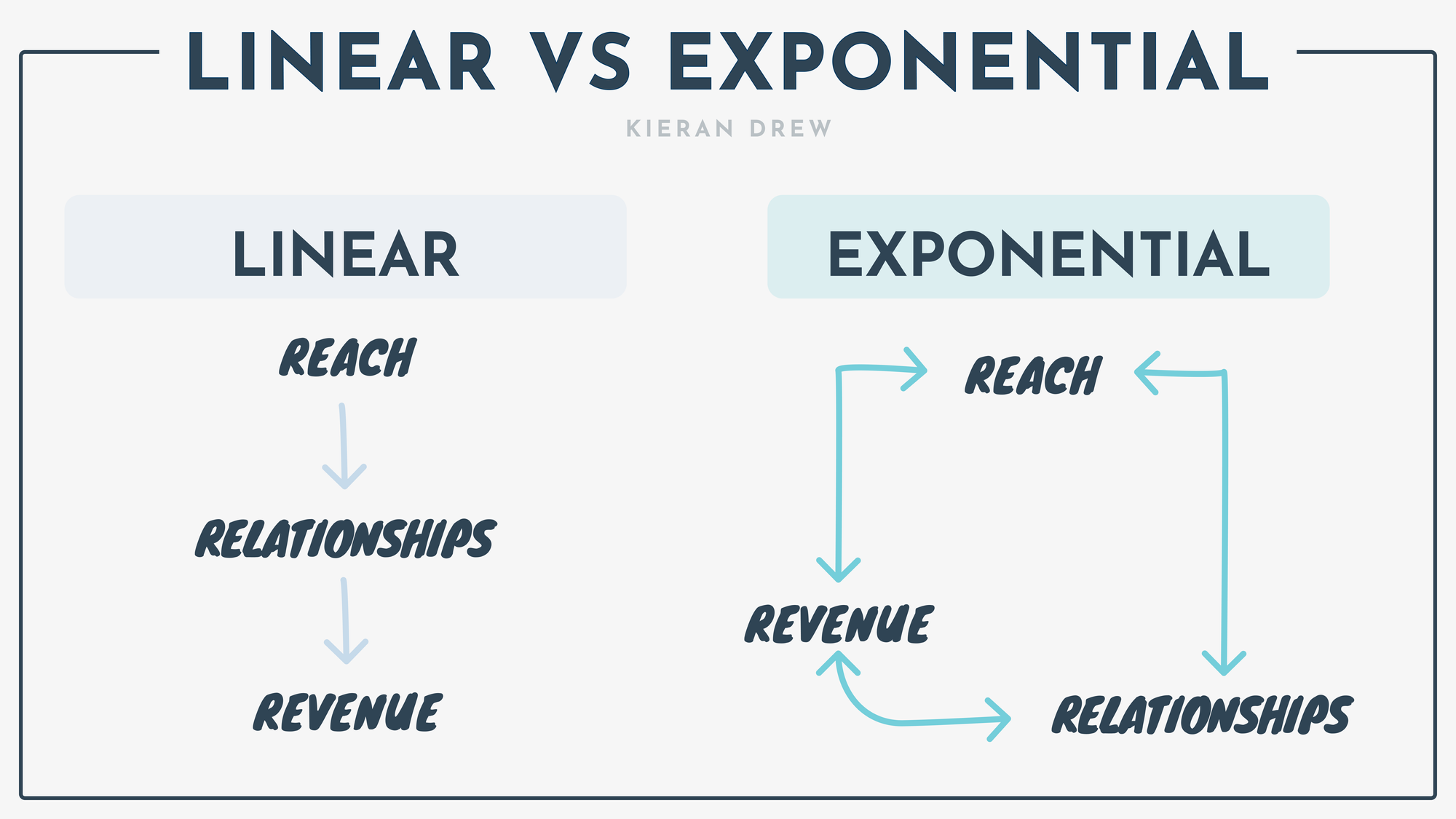
You have, in effect, created an energy multiplier — one unit invested leads to one hundred generated. At this point, people wonder how the hell you’re doing it.
Now's the time to play to your strengths.
For example, I love writing — so I’m doubling down on content, knowing that the better I write, the better business goes. But if you’re great at offers, you might build out your back end (explained below).
Either way, you’ll be having a lot of fun, and that’s when you become unstoppable.
The Hybrid Writing Business Model
The plan above is already a six-to-seven-figure business model. But I’d like to finish this phase by showing how you might set up a system such that the more you write, the more you earn.
The hybrid writing business model is optimized for one goal: High-leveraged income. It’s a goal I’m passionate about. Done well, you'll disconnect your time from money and earn with your mind.
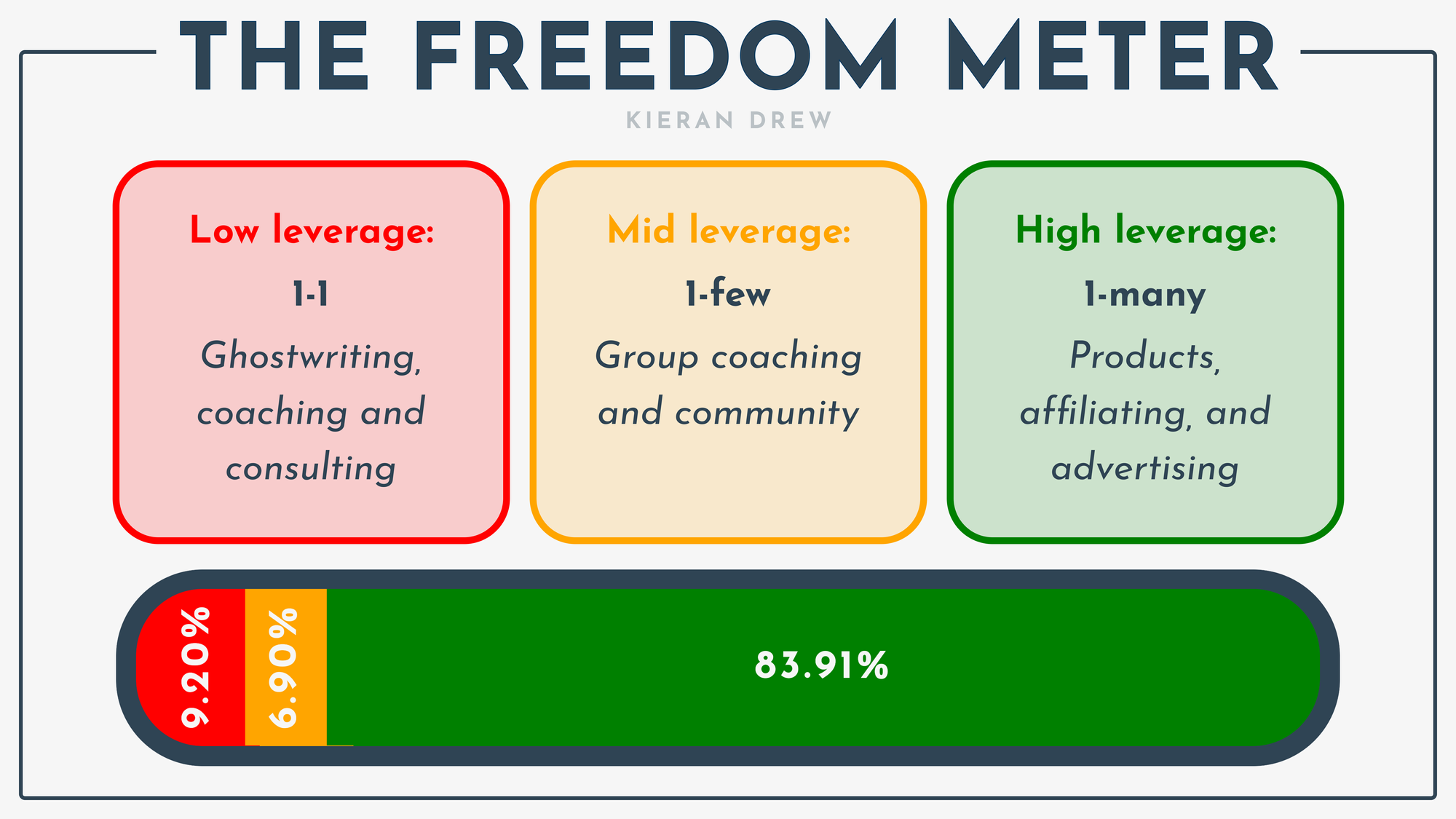
Let's discuss one way to achieve it.
REACH
Main social media channel + secondary
Pick complimentary channels where your One True Fan hangs out. Repurpose your best-performing content onto the secondary channel. Build lead magnets to plug under your posts to drive newsletter sign-ups.
RELATIONSHIPS
Newsletter + website + (optional) some video or audio content
The aim is to build a rabbit hole of unique and useful ideas for your reader. As your body of work grows, and you automate the journey, you can take someone from a follower to a fan without lifting a finger except by sharing your thoughts on social media.
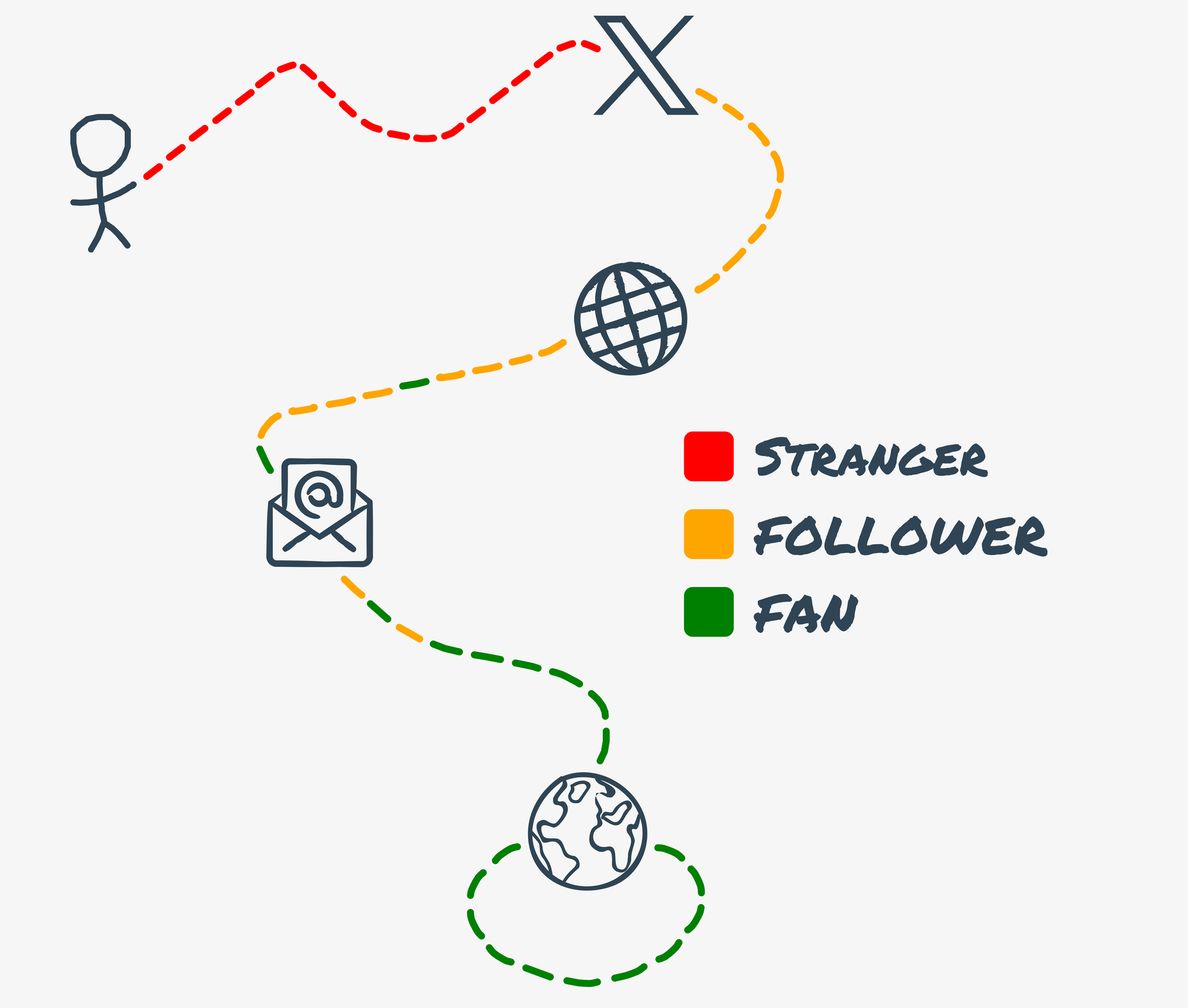
This essay is an example.
You’re still here, so you either don’t have much to do today or find this valuable. Hopefully it’s the latter, and hopefully, you like me more for it. It's taken a long time to write, but all I need to do now is share this asset often.
But it’s hard to build intimacy through words alone.
When someone sees and hears you speak, they can put a face to the words and will read in your voice. This is powerful. People are always surprised to hear that I’m British!
For video, you could start a YouTube channel, but that's a big project. You should start only when you have the resources and patience to see it through. Instead, you can get the 80:20 result by:
- Doing podcast/space interviews
- Turning some of your best ideas into video
- Building an authority asset like a video course
REVENUE
Offer 1 (front end) + Offer 2 (back-end) + bonus income
Build your offers around one premise:
The more access you give, the more money you charge.
Picture your business like a physical store.
The first offer, your ‘front end’, is a welcoming entrance, attracting a wide range of potential customers. This means it should be something you can sell at scale, such as a:
- Digital product
- Paid newsletter
- Community
The front end generates revenue, but more importantly, it builds relationships. You then have your back end, the VIP section of the store. Here’s where your fans hang out, and where you increase the lifetime value of your buyers with more products or services.
Pricing depends on your approach.
For example, Justin Welsh has several $150 front-end products with a simple $9 upsell. He has the benefit of scale and isn’t interested in selling his time. Jay Clouse has a $699/year subscription for his courses and a $1999/year for his community.
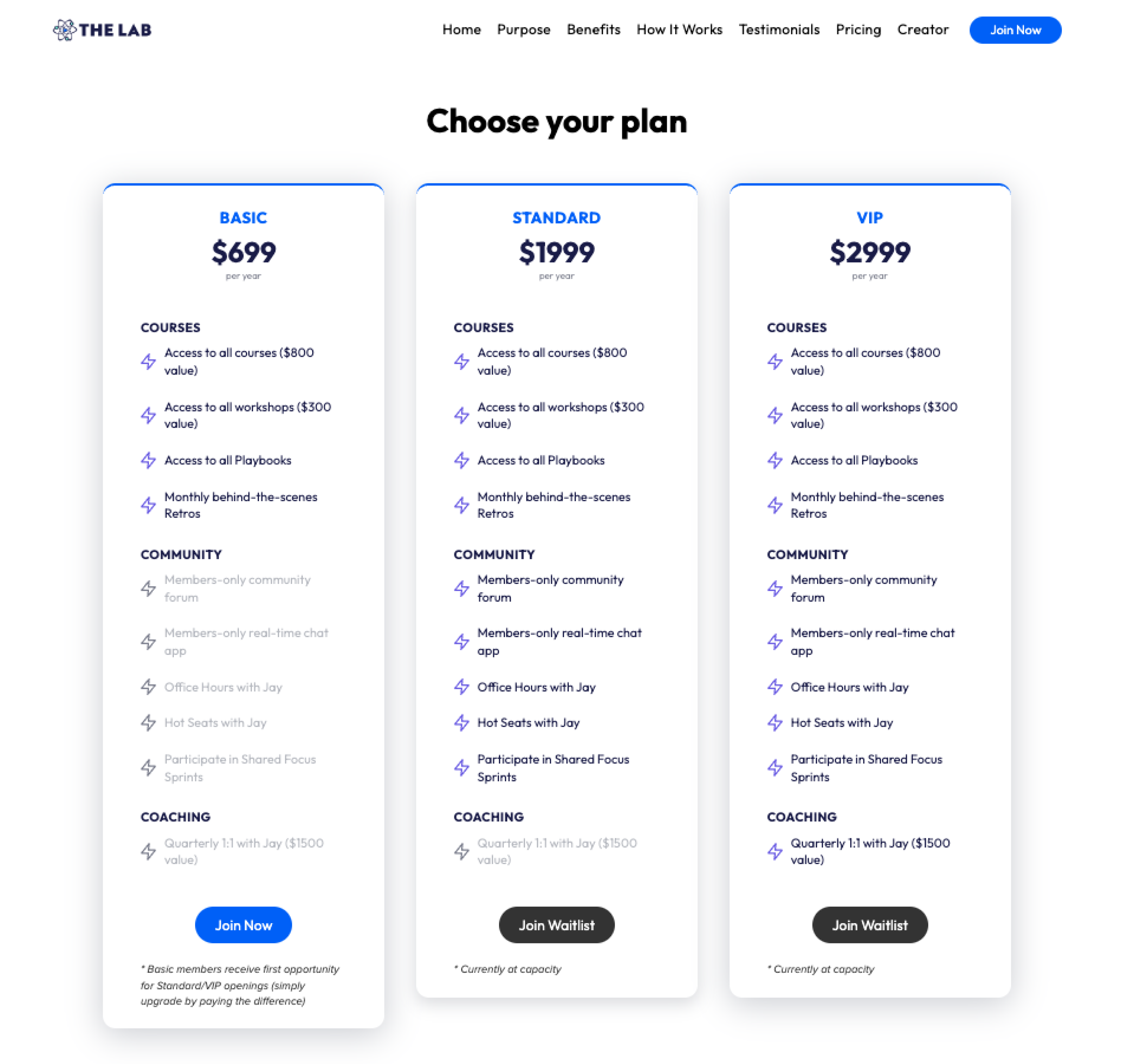
As an entrepreneur, you decide what success looks like — so get clear on what you want before you build it (the value-first approach). To me, it’s an empty calendar. After seeing 30 patients a day as a dentist, nothing makes me smile more than having one meeting per week. So I rarely sell my time, even if I make much less.
You also have several other options to monetise without creating offer overwhelm:
- Advertising and brand partnerships: ‘Rent space’ to businesses who serve the same audience
- Affiliating: Partner with other businesses to promote their offers
- Micro-products: Solve small problems (benefit of more buyers)
- Challenges: This is a good way to unite your audience without launching a community. For example, if you were a fitness entrepreneur, you could run a 30-day weight loss challenge.
But note:
Whatever you decide to build or promote, make sure it’s excellent.
Positive word-of-mouth marketing is the fastest way to grow your business. Negative word-of-mouth marketing is the fastest way to ruin it.
PROGRESSING TO PHASE 4
I know, I know. I promised only three phases.
But don’t worry; I won’t keep you much longer. I would do you a disservice if I didn't briefly explain what we can learn from the top 0.1% of online entrepreneurs:
The pioneers.
A pioneer is at the forefront of their industry. They’re the visionaries who challenge the status quo and push the boundaries of what’s expected.
By definition, there’s no blueprint to follow. Pioneers exist because they choose not to follow in someone else’s footsteps. But success leaves clues. And there're three clues you should pay attention to.
1) Become the only
"Become the best in the world at what you do. Keep redefining what you do until this is true."
- Naval Ravikant
Pioneers have made the pursuit of their curiosity a life-long journey. This is easier said than done. The bigger the crowd, the more susceptible you are to pleasing it. But online, uniqueness is celebrated — so follow your intuition for every decision. Be ready to tear down the walls and rebuild based on your gut.
2) Be the chess player
The difference between the successful and ultra-successful isn’t how hard they work, but how leveraged they become.
Take Joe Rogan. He’s just one voice. But by amplifying what he does best, he’s become one of the most influential people in the world. The key is identifying what you can do better than anyone else and applying leverage to multiply your impact.
“Only once you give yourself permission to stop trying to do it all, to stop saying yes to everyone, can you make your highest contribution towards the things that really matter.”
- Greg Mckeown, Essentialism
See it as the difference between being a chess piece or chess player.
One is on the board, doing the work. The other is allocating resources and letting the world work for them.
But you don’t need a big team to do this. James Clear has 2 million newsletter subscribers yet only has two full-time staff. He's combined an audience, software, and media to get staggering results.
Leading us to the final and most important point of this essay.
3) Play Infinite Games
In Finite and Infinite Games, James P. Carse explains how embracing an infinite mindset leads to a meaningful and fulfilling life.
Finite games have rules and boundaries, winners and losers.
Infinite games are the opposite. You don’t play them to win; you play for the joy of playing. They’re a celebration of the process instead of the outcome.
The problem with finite games is that they encourage zero-sum thinking and are often unsustainable. You might get great early results, but you’ll never be able to compete with the person playing for the joy of playing (because they’re not competing).
There're three games worth playing:
- Relationships
- Mastery
- Impact
RELATIONSHIPS
Although some think otherwise, you can’t win relationships. They're a mutually beneficial exchange that compounds the more you play.
For example, the more you support your fans, the more they’ll support you. The more you collaborate instead of compete, the more opportunities you create.
Share what you know freely and help others selflessly. It’ll come back tenfold.
MASTERY
Mastery isn’t about becoming the best at something; it’s about who you become while pursuing it. As Derek Sivers said, "Mastery is the best goal because the rich can't buy it, the impatient can't rush it, the privileged can't inherit it, and nobody can steal it. You can only earn it through hard work.”
Malcolm Gladwell popularised the concept of 10,000 hours to mastery. But it’s misleading. After all, most people will drive for 10,000 hours, yet you know as well as I do that the roads aren’t full of Formula One drivers.
The difference? Deliberate practice.
… Not 10,000 repetitions, but 10,000 iterations.
“Mastery is not a destination; it is a continuous journey of growth, learning, and refinement."
- Robert Greene, Mastery
The first step to mastery is to commit to skills that look like work to others but feel like play to you. To paraphrase Tim Cook, the CEO of Apple, if you can get paid to do the thing you love, you’ll never work harder in your life. But the tools will feel light in your hands.
This leads us to the final point:
IMPACT
The internet rewards those who are most useful. Your income is just a measure of your impact. This means the best game to play is to serve your audience. There will always be more problems to solve and more exciting things to build.
Measure your success by how much you help, not how high you climb — and you’ll be surprised how far you go.
Best of luck and thanks for reading.
1. Get a step-by-step blueprint for attracting an engaged audience with High Impact Writing
2. Join a weekly masterclass and get 5 content ideas delivered to your inbox every Thursday
About Kieran
Ex dentist, current writer, future Onlyfans star · Sharing what I learn about writing well, thinking clearly, and building an online business